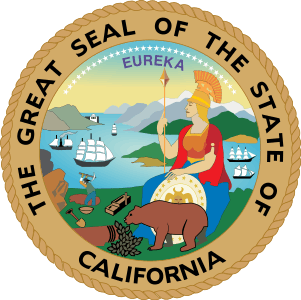History of California 1900–present
This article continues the history of California in the years 1900 and later. For events through 1899, see History of California before 1900.
Part of a series on the |
|---|
| History of California |
 |
| Periods |
| Topics |
| Cities |
|
|
After 1900, California continued to grow rapidly and soon became an agricultural and industrial power. The economy was widely based on specialty agriculture, oil, tourism, shipping, film, and after 1940 advanced technology such as aerospace and electronics industries – along with a significant military presence. The films and stars of Hollywood helped make the state the "center" of worldwide attention. California became an American cultural phenomenon; the idea of the "California Dream" as a portion of the larger American Dream of finding a better life drew 35 million new residents from the start to the end of the 20th century (1900–2010).[1] Silicon Valley became the world's center for computer innovation.
California demographics
| Historical population | |||
|---|---|---|---|
| Census | Pop. | %± | |
| 1840 | 8,000 | — | |
| 1850 | 120,000 | 1,400.0% | |
| 1860 | 379,994 | 216.7% | |
| 1870 | 560,247 | 47.4% | |
| 1880 | 864,694 | 54.3% | |
| 1890 | 1,213,398 | 40.3% | |
| 1900 | 1,485,053 | 22.4% | |
| 1910 | 2,377,549 | 60.1% | |
| 1920 | 3,426,861 | 44.1% | |
| 1930 | 5,677,251 | 65.7% | |
| 1940 | 6,907,387 | 21.7% | |
| 1950 | 10,586,223 | 53.3% | |
| 1960 | 15,717,204 | 48.5% | |
| 1970 | 19,953,134 | 27.0% | |
| 1980 | 23,667,902 | 18.6% | |
| 1990 | 29,760,021 | 25.7% | |
| 2000 | 33,871,648 | 13.8% | |
| 2010 | 37,253,956 | 10.0% | |
| Sources: 1850–2010 U.S. Census[2] * The 1850 statistics are corrected for lost census data in San Francisco, Santa Clara and Contra Costa Counties. California Indians were not counted before the 1870 census. | |||
California is now the most populous state in the United States. If it were an independent country, California would rank 34th in population in the world. California has had waves of immigration and emigration over the years. The first big wave was the California Gold Rush starting in 1848 of miners, businessmen, farmers, loggers, etc. as well as their many supporters.
There were fewer than 10,000 females in a total California population (not including Native Americans who were not counted) of about 120,000 residents in 1850. About 3.0% of the gold rush Argonauts before 1850 were female or about 3,500 female Gold Rushers, compared to about 115,000 male California Gold Rushers. Massive immigration from mostly other states continued throughout the nineteenth century.[3][4] California did not reach a "normal" male to female ratio of about one to one until the 1950 census. California for over a century was short on females.
The 1900 census showed emigrations down to "only" a 20% growth rate. The early 1900s showed a massive population increase of over 60% between 1900 and 1910. The population more than doubled again in the next 20 years by 1930. Foreign immigration largely ceased during the Great Depression, as immigration to the United States was held to a low of 23,068 per year by 1933, and many foreign workers were deported. There were not enough jobs to go around. After World War II and the Great Depression, there was a rapidly increasing buildup of United States workers in California as wartime industries boomed. Most of these workers were from other states as they settled in California and increased the California population to 10,586,223 by 1950. Immigration to the United States only started to increase significantly in 1946, when immigration to all of the United States was back up to 108,721 per year[3] The continuing prosperity and emigration from other states and immigration from other countries in the 1950s and 1970s almost doubled the California population again to 19,953,134 by 1970. The 1970–2010 population growth has still been substantial but has slowed to "only" about a 15% growth rate per decade. By 2010 the California population growth rate slowed slightly to 10%.
California earthquakes
Earthquakes in California are common occurrences since the state is traversed by six major strike-slip fault systems with hundreds of related faults, many of which are "sister faults" of the infamous San Andreas Fault that runs nearly the full length of California at the juncture of the Pacific Plate and the North American Plate. The fault systems include the Hayward Fault Zone, Calaveras Fault, Clayton-Marsh Creek-Greenville Fault, and the San Gregorio Fault. Significant blind thrust faults (faults with near vertical motion and no surface ruptures) are associated with portions of the Santa Cruz Mountains and the northern reaches of the Diablo Range and Mount Diablo. The California earthquake forecast gives a rough estimate of where the main earthquake zones in California are. Earthquake damage depends on what area is hit, how close to the surface the center of the earthquake is located, and its magnitude. Earthquake damage, for a given magnitude earthquake, to human structures depends on how well the buildings are built and what the structures are located on. Buildings on soft or filled-in soil suffer the most because they feel shock waves most strongly. Buildings on bedrock suffer less damage because the ground is firmer. Sometimes the ensuing fires, floods or tsunamis caused by the earthquake are often where the greatest damage occurs.
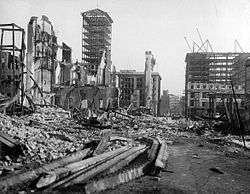
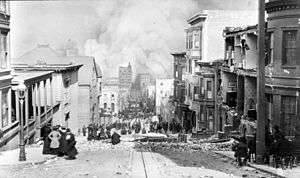
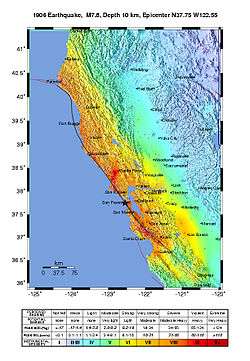
The 1906 San Francisco earthquake struck the city (then the largest in California) and nearby communities at 5:12 a.m. on Wednesday, April 18, 1906.[5] Devastating fires broke out in the city that lasted for several days, destroying about 28,000 buildings. As a result of the quake and fires, over 3,000 people died[6] and over 80% of San Francisco was destroyed. The death toll from the earthquake and resulting fire is the greatest loss of life from a natural disaster in California's history.
The most widely accepted estimate for the magnitude of the earthquake is a moment magnitude (Mw) or Richter magnitude (ML) of 7.8;[7] however, other values have been proposed, from 7.7 to as high as 8.25.[8] Shaking was felt from Oregon to Los Angeles, and inland as far as central Nevada.[9]
The San Francisco 1906 earthquake was caused by a rupture on the San Andreas Fault, a continental transform fault that forms part of the tectonic boundary between the Pacific Plate and the North American Plate. The fault is characterized by mainly lateral motion where the western (Pacific) plate moves northward relative to the eastern (North American) plate. The 1906 rupture propagated both northward and southward from its epicenter for a total of about 300 miles (480 km).[10] The San Andreas Fault runs the length of California from the Salton Sea in the south to Cape Mendocino to the north, a distance of about 810 miles (1,300 km). The earthquake ruptured the northern third of the fault for a distance of about 300 miles (480 km). The maximum observed surface displacement was about 20 feet (6.1 m); however, geodetic measurements show displacements of up to 28 feet (8.5 m) in some places.[11] The most recent analysis by the United States Geological Survey (USGS) shows that the most likely epicenter of the 1906 earthquake was very near Mussel Rock on the coast of Daly City, an adjacent suburb just south of San Francisco.[12]
A strong foreshock preceded the mainshock by about 20 to 25 seconds. The strong shaking of the main shock lasted about 42 seconds. The shaking intensity as described on the Modified Mercalli intensity scale reached VIII in San Francisco and up to IX in areas to the north like Santa Rosa, where destruction was devastating. There were decades of minor earthquakes – more than at any other time in the historical record for northern California – before the 1906 quake. They have been widely interpreted subsequently as precursory activity to the 1906 earthquake.[13]
| Significant California earthquakes | ||
|---|---|---|
| Earthquake | Magnitude | Fatalities |
| 1906 San Francisco | 7.8 | 3,000+1 |
| 1925 Santa Barbara | 6.3–6.8 | 13 |
| 1933 Long Beach | 6.4 | 115 |
| 1952 Kern County | 7.3 | 12 |
| 1971 San Fernando | 6.6 | 65 |
| 1989 Loma Prieta | 6.9 | 63 |
| 1994 Northridge | 6.7 | 60 |
| Notes: 1. The 1906 San Francisco earthquake caused so much damage that the authorities "lied" about the number of casualties. Subsequent research has shown that about 3,450 were "known" to have died. Some more were shot for looting. | ||
Due to a widespread practice by insurers to indemnify San Francisco properties from fire, but not earthquake damage, most of the destruction in the city was blamed on the fires. Some property owners deliberately set fire to damaged properties in order to claim them on their insurance. Capt. Leonard D. Wildman of the U.S. Army Signal Corps[14] reported that he "was stopped by a fireman who told me that people in that neighborhood were firing their houses… they were told that they would not get their insurance on buildings damaged by the earthquake unless they were damaged by fire. The insurance industry eventually paid out over $250,000,000 (the largest amount they paid out for the next 60 years) which significantly helped to rebuild the city."[15] Building standards of the original 1906 buildings had almost no earthquake resistance built in. Since 1906 earthquake standards have been steadily upgraded as damages caused by earthquakes are investigated. Unfortunately, a lot of older buildings do not meet today's standards, and it would typically cost too much to upgrade them. It was discovered in 1906 (again) that all masonry-type structures built of brick and un-reinforced concrete are resistant to fire but not earthquakes.[16] A detailed analysis of the city of San Francisco today estimates that an earthquake over 7.0 magnitude would completely destroy or seriously damage many sections of San Francisco and could possibly result in thousands of deaths.[16] Today in most communities, structures built to later earthquake standards would do well in all but the strongest earthquakes. The water mains and other infrastructure needed for fighting fires have all been upgraded but are yet untested.
California oil industry
California pioneers after 1848 discovered an increasing number of oil seeps—oil seeping to the surface, especially in Humboldt, Colusa, Santa Clara, and San Mateo counties, and in the asphaltum seeps and bituminous residues in Mendocino, Marin, Contra Costa, Santa Clara, and Santa Cruz counties. In Southern California, large seeps in Ventura, Santa Barbara, Kern, and Los Angeles counties received the most attention.[17] Interest in oil and gas seeps was stirred in the 1850s and 1860s, becoming widespread after the 1859 commercial uses of oil were demonstrated in Pennsylvania. Kerosene quickly replaced whale oil for lighting, and lubricating oils became an essential product in the Machine Age. Other uses later in the 19th century included providing paving material for many roads and providing power for many steam locomotives and steam-powered shipping—replacing coal.
Oil became a major California industry in the 20th century with the discovery of new fields around Los Angeles and the San Joaquin Valley, and the dramatic explosion in demand for gasoline to fuel the rapidly growing number of automobiles and trucks now being produced. Most of the oil production in California began in the late 19th century.[18] At the turn of the century, oil production in California continued to rise at a booming rate. In 1900, the state of California produced 4 million barrels.[18] In 1903, California became the leading oil-producing state in the US, and traded the number one position back and forth with Oklahoma through 1930.[19] Production at the various oil fields increased to about 34 million barrels per year by 1904. By 1910 production had reached 78 million barrels. California drilling operations and oil production are concentrated primarily in Kern County, the San Joaquin Valley, and the Los Angeles Basin.
As of 2012, California was the nation's third most prolific oil-producing state, behind only Texas and North Dakota. In the past century, California's oil industry grew to become the state's number one GDP export and one of the most profitable industries in California.[20]
There is also some offshore oil and gas production in California, but there is now a moratorium on new offshore oil and gas leasing and drilling in California waters and a deferral of leasing in federal waters. These restrictions were imposed after a series of accidents in the 1969 Santa Barbara oil spill released oil into the Pacific Ocean.[21]
.jpg)
In 1920, oil production in California had expanded to 77 million barrels.[18] Between 1920 and 1930, new oil fields across Southern California were being discovered with regularity, including Huntington Beach in 1920, Long Beach and Santa Fe Springs in 1921, and Dominguez in 1923.[18] Southern California had become the hotbed for oil production in the United States.
However, the development of increased oil production in California had consequences. The additional California oil fields, along with booming oil supplies in Texas and Oklahoma, put downward pressure on the price. In the 1930s the Texas Railroad Commission tried to take charge of allocating oil production among the states to keep prices from falling to a few pennies a barrel.
After a century, the San Joaquin Valley remains a major producer. The Kern County part of the valley in 2008 had over 42,000 producing oil wells that provided about 68% of the oil produced in California, 10% of the entire United States production, and close to 1% of the total world oil production. Add to that another producing 2,000 wells in Fresno County. If the valley were a state in its own right, it would rank behind Texas, Alaska, and Louisiana as the fourth largest oil producer state in the country.
| California oil production in 2005[22] | |
|---|---|
| State | Barrels/day |
| Louisiana | 1,463,000 |
| Texas | 1,331000 |
| Alaska | 894,000 |
| California San Joaquin Valley | 515,000 |
| Oklahoma | 177,000 |
| New Mexico | 171,000 |
The San Joaquin Valley is also home to 21 giant oil fields that have produced over 100 million barrels of oil each, with four "super giants" that have produced over 1 billion barrels of oil. Among these "super giants" are Midway-Sunset, the largest oil field in the lower 49 United States, and Elk Hills, the former United States Naval Petroleum Reserve.
For a chronology of the state's oil industry see California oil and gas industry#Chronology of the California oil industry.
Natural gas
In 2012 the state was the 13th largest producer of natural gas in the United States, with a total annual production of 248 billion cu feet of gas.[23] Today natural gas is the second most widely used energy source in California. About 45% is now burned in gas-fired plants for electricity generation; the proportion increases as coal-burning plants are phased out and nearly all new plants are powered by natural gas. One of the main advantages of natural gas is that it only produces about 55% as much CO2 as coal for the same amount of electricity produced. About 9% of the natural gas is used in facilitating the extraction of more oil and gas. Another 21% is used for residential space and water heating, cooking, clothes drying, etc.; 9% is used for commercial building and water heating, and 15% is used in industrial use.[24] California imports about 85% of its natural gas, using six large gas pipelines from Texas, New Mexico and Canada.
California businessmen
In 1911 a new California Assembly created a new railroad commission with vastly enlarged powers and brought public utilities under state supervision. Organized businessmen were the leaders of both of these reforms. The driving force for railroad regulation came less from an outraged public seeking lower rates than from shippers and merchants who wanted to stabilize their businesses. Public utility officers spearheaded campaigns for the passage, and later the enlargement of the Public Utilities Act. They expected that state regulation would reduce wasteful competition between their companies, improve the value of their companies' securities, and allow them to escape continual wrangling with county and municipal authorities.[25]
Although the businessmen were influential in obtaining the passage of bills they wanted, no group of businessmen dominated the California legislature or the railroad commission after 1910. Legislation proposed by some businessmen was opposed by other business interests.[25] Organized labor made significant gains during the Progressive Era, but they were not a result of benevolent, middle-class reformer actions, but of powerful lobbying activity on the part of unions with their solid base in San Francisco and Oakland.
In the 1920s, most progressives came to view the business culture of the day not as a repudiation of progressive goals but as the fulfillment of it. The most important progressive victories of 1921 were the passage of administrative reorganization laws, the King Bill, increasing corporate taxes, and a progressive budget. In 1927–31, governor Clement Calhoun Young (1869–1947) brought more progressivism to the state. The state began large-scale hydroelectric power development, and began state aid to the handicapped. California became the first state to enact a modern old-age pension law. The state park system was upgraded, and California (like most states) rapidly expanded its highway program, funding it through a tax on gasoline, and creating the California Highway Patrol.[26]
California women
California women had the right to own property in their own name since the first California Constitution in 1850. In 1911 California voters, in a special election, narrowly granted women the right to vote, nine years before the 19th Amendment enfranchised women nationally in 1920, but over 41 years later than the women of Wyoming had been granted the right to vote. Women's clubs flourished and turned a spotlight on issues such as public schools, dirt and pollution, and public health. California women were leaders in the temperance movement, moral reform, conservation, public schools, recreation, and other issues. They helped pass the 18th amendment, which established Prohibition in 1920. Initially, women did not often run for public office.[27]
Progressive Era
California played a major role in the Progressive Movement. It was the only state where the Progressives took control of the Republican Party.
Lincoln–Roosevelt League
California was a leader in the Progressive Movement from the 1890s into the 1920s. A coalition of reform-minded Republicans, especially in southern California, coalesced around Thomas Bard (1841–1915). Bard's election in 1899 as United States senator enabled the anti-machine Republicans to sustain a continuing opposition to the Southern Pacific Railway's political power in California. They helped nominate George C. Pardee for governor in 1902 and formed the "Lincoln–Roosevelt League". In 1910 Hiram W. Johnson won the campaign for governor under the slogan "Kick the Southern Pacific out of politics." In 1912 Johnson became the running mate for Theodore Roosevelt on the new Bull Moose Party ticket.[28]
By 1916 the Progressives were supporting labor unions, which helped them in ethnic enclaves in the larger cities but alienated the native-stock Protestant, middle-class voters who voted heavily against Senator Johnson and President Wilson in 1916.[29]
Political progressivism varied across the state. Los Angeles (population 102,000 in 1900) focused on the dangers posed by the Southern Pacific Railroad, the liquor trade, and labor unions; San Francisco (population 342,000 in 1900) was confronted with a corrupt union-backed political "machine" that was finally overthrown following the earthquake of 1906. Smaller cities like San Jose (which had a population of 22,000 in 1900) had somewhat different concerns, such as fruit cooperatives, urban development, rival rural economies, and Asian labor.[30] San Diego (population 18,000 in 1900) had both the Southern Pacific and a corrupt machine.[31]
World War I
California played a major role in terms of agriculture, industry, finance and propaganda during World War I.[32] Its industrialized agriculture exported food to the Allies, 1914–1917, and expanded again when America entered the war in 1917. After the war ended, it shipped large quantities of food to central Europe as part of national relief efforts. Hollywood was thoroughly engaged, with feature films and training films.[33] Attractive climate conditions led to the addition of numerous Army and Navy training camps and airfields. Construction of transports and warships boosted the economy of the Bay area.
Organized labor
Organized labor was centered in San Francisco for much of the state's early history. By the opening decades of the twentieth century, labor efforts had expanded to Los Angeles, Long Beach and the Central Valley. In 1901, the San Francisco-based City Front Federation was reputed to be the strongest trade federation in the country. It grew out of intense organizational drives in every trade during the boom around the start of the 20th century.
Employers also organized during the building trades strike of 1900 and the (San Francisco) City Front Federation strike of 1901, which led to the founding of the Building Trades Council. The open shop question was at stake. Out of the City Front strike came the Union Labor Party, because workers were angry at the mayor for using the police to protect strikebreakers. Eugene Schmitz was elected mayor in 1902 on the party's ticket, making San Francisco the only town in the United States, for a time, to be run by labor. A combination of corruption and unscrupulous reformers culminated in graft prosecutions in 1907.
In 1910, Los Angeles was still an open shop, and employers in the north threatened for a new push to open San Francisco shops. Responding, labor sent delegations south in June 1910. National organizers were sent in during a lockout of 1,200 idled metal-trades workers. Then occurred an incident that would set back Los Angeles organizing for years: on October 10, 1910, a bomb exploded at the Los Angeles Times newspaper plant that killed 21 workers.
In the decade following, the rapid growth of the Industrial Workers of the World (IWW, or Wobblies) in un-unionized trades, logging, wheat farming, and lumber camps began extending its efforts to mines, ports and agriculture. The IWW came to public notice after the Wheatland Hop Riot, when a sheriff's posse broke up a protest meeting and four people died. It led to the first legislation protecting field labor. The IWW was harmed by anti-union drives and prosecution of members under the California Criminal Syndicalism Act.
The IWW was also involved in the 1923 seamen's strike at San Pedro, where Upton Sinclair was arrested for reciting the Declaration of Independence. The man who became the most prominent Wobbly of all, Thomas Mooney, soon became a cause-celebre of labor and the most important political prisoner in America.
Labor in the 1920s
The Preparedness Day Bombing killed ten people and hurt labor for decades. During the 1920s, the open shop efforts succeeded through a coordinated strategy called the "American Plan". In one case, the Industrial Association of San Francisco raised over a million dollars to break the building trades strikes in 1921 that led to the collapse of the building trades unions. This employers association cut wages twice in one year, and the Metal Trades Council was defeated, losing an agreement that had been in effect since 1907. The Seamen's Union also suffered defeat in 1921.
Labor in the 1930s
Labor unions
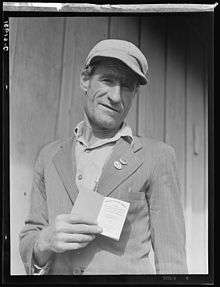
Unions grew rapidly after 1935 with political and legal support from the national New Deal and its Wagner Act of 1935. The most serious strike came in 1934 along the state's ports. In May 1934, dock workers and longshoremen along the West Coast went on strike for better hours and pay, a union hiring hall and a coast-wide contract. Communists were in control of the union, the International Longshoremen's Association (ILA), led by Harry Bridges (1901–1990).[34]
On "Bloody Thursday", July 5, 1934, San Francisco was swept by bloody rioting. Striking maritime workers, pitting themselves against police, took control of much of the waterfront and warehouse areas of the city. Two workers were killed and hundreds were clubbed and gassed. The West Coast Waterfront Strike lasted 83 days, with longshoremen returning to work on July 31. Arbitration was agreed to, and it resulted in a victory for the strikers and the unionization of all West Coast ports in the United States.[34]
San Francisco in the late 1930s had 120,000 union members. Longshoremen wore union buttons on their white union-made caps, Teamsters drove trucks as unionists, and fishermen, taxi drivers, streetcar conductors, motormen, newsboys, retail clerks, hotel employees, newspapermen and bootblacks all had representation. Against 30,000 trade union members in 1933–34, Los Angeles by the late thirties had 200,000, even against a severe 1938 anti-picketing ordinance. But Los Angeles became unionized in the mass production industries of aircraft, auto, rubber, and oil, and at the yards of San Pedro. Later, drives for unionization spread through musicians, teamsters, building trades, movies, actors, writers and directors.
Farm labor
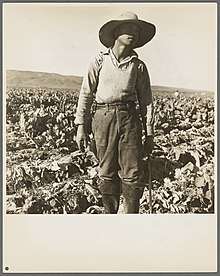
Farm labor remained unorganized, the work brutal and underpaid. In the 1930s, 200,000 farm laborers traveled the state in tune with the seasons. Unions were accused of an "inland march" against landowners' rights when they took up the early effort to organize farm labor. A number of valley towns endorsed anti-picketing ordinances to thwart organizing.
In the 1933–1934 period, a wave of agricultural strikes flooded the Central Valley, including the Imperial Valley lettuce strike and San Joaquin Valley cotton strike. In the 1936 Salinas lettuce strike, vigilante violence shocked the nation. Again, in the spring of 1938, about three hundred men, women and children were driven by vigilantes from their homes in Grass Valley and Nevada City.
A 1938 ballot proposition against picketing, "Proposition #1", considered fascist by commentators for the state grange, became a huge political struggle. Proposition #1 failed at the polls. Soon, racist distinctions fell as California unions began to admit non-white members.
By the advent of World War II, California had an old-age assistance law, unemployment compensation, a 48-hour work week maximum for women, an apprentice law, and workplace safety rules.
Okies
"Okies" were the 250,000 hard-luck migrants who fled the Dust Bowl and depression in Oklahoma and neighboring states in the 1930s in search of a better future. Many sought farm labor jobs advertised in the Central Valley. They were harshly disparaged at the time. Police were stationed at the Arizona line to keep them out, and the state legislature passed a law to keep them out, but it was overturned by the United States Supreme Court.[35] Historian James Gregory has explored the long-term impact of the Okies on California society. Gregory finds that most came from urban backgrounds, and one in six had been a white-collar worker. He notes that in The Grapes of Wrath, novelist John Steinbeck saw the migrants becoming active agitators for unions and the New Deal, demanding higher wages and better housing conditions. Steinbeck did not foresee that most Okies would move into well-paid jobs in war industries in the 1940s. The children and grandchildren of the Okies seldom returned to Oklahoma. They did leave the farms and became concentrated in Southern California's cities and suburbs. Long-term cultural impacts include a commitment to evangelical Protestantism (especially the Pentecostals and the Southern Baptists[36]), a love of country music,[37] populist conservatism of the sort that boosted Reagan, and strong support for traditional moral and cultural values.[38][39]
Radical politics
In the 1934 California gubernatorial election, novelist Upton Sinclair was the narrowly defeated Democratic nominee, running on the platform of the socialist End Poverty in California (EPIC) movement, a radical response to the Great Depression. Other radical movements flourished, such as the Townsend Plan for old age pension, and "Ham and Eggs", which promised "$30 Every Thursday" to everyone over age 50. Voters narrowly rejected it in 1938, and the utopians failed to enact any panaceas; however, the movements did spawn a generation of activists on the left.[40]
Water projects
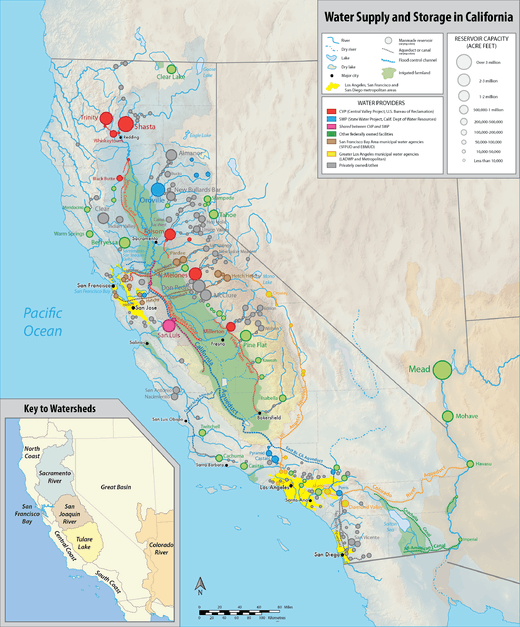
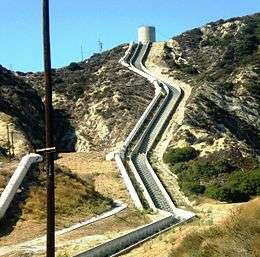
The only way California can support its extensive population and agriculture is to store water in numerous reservoirs and use pipes, tunnels, pumps and canals to distribute it where it is needed when it is needed. Beginning before 1900, California has built extensive water projects costing many billions of dollars to store and move water where it is needed. California water comes primarily from snowfall in the Sierra Nevada in the northern part of the state during the relatively short winter from about October to March. The rest of the year typically has very little rainfall or snowfall. California weather is also prone to extended droughts that can last several years. During an average rainfall year, about 14% of the power used in California is generated by hydroelectricity.[41]
Los Angeles Aqueduct
The Los Angeles Aqueduct runs from the Owens Valley, through the Mojave Desert and its Antelope Valley, to dry Los Angeles far to the south. The aqueduct project began in 1905 when the people of Los Angeles approved a US$1.5 million bond for the "purchase of lands and water and the inauguration of work on the aqueduct".[42][43]
On June 12, 1907, a second bond was passed with a budget of US$24.5 million to fund the project.[42][44] Construction began in 1908 and finished in 1913 while employing 5,000 workers during that period.[45][46][47][48]
The Los Angeles aqueduct as originally constructed consisted of six storage reservoirs and 215 miles (346 km) of conduit. Beginning 3.5 miles (5.6 km) north of Black Rock Springs, the aqueduct diverts the Owens River into an unlined canal to begin its 233-mile (375 km) journey south to the Lower San Fernando Reservoir.[49] This reservoir was later renamed the Lower Van Norman Reservoir. Creeks flowing from the eastern Sierra are diverted into the aqueduct.
The original project consisted of 24 miles (39 km) of open unlined canal, 37 miles (60 km) of lined open canal, 97 miles (156 km) of covered concrete conduit, 43 miles (69 km) of concrete tunnels, and 12.05 miles (19.39 km) of steel siphons. To build it required 120 miles (190 km) of railroad track, two hydroelectric plants, three cement plants, 170 miles (270 km) of power lines, 240 miles (390 km) of telephone line, and 500 miles (800 km) of roads.[50] It was later expanded with the construction of the Mono Extension and the Second Los Angeles Aqueduct.[51]
The Los Angeles Aqueduct uses gravity alone to move water and to generate electricity, so it is cost-efficient to operate.[52] Finished in 1911, the Los Angeles Aqueduct was the brain-child of the self-taught engineer William Mulholland and is still in use today.
Hetch Hetchy
Hetch Hetchy is a valley that lies in the northwestern part of Yosemite National Park and is drained by the Tuolumne River. Starting in about 1901, San Francisco started looking for a new supply of municipal water. Following the disastrous 1906 San Francisco earthquake and fire, this search intensified, and they finally chose the Tuolumne River as the "best" available water resource. The City and County of San Francisco bought most of the water rights to the Tuolumne River watershed in 1910. The Hetch Hetchy project centered on damming the main Tuolumne River as it meandered through Hetch Hetchy's wide glacial-cut valley. The river, with its source in a perpetual glacier on 13,000-foot (4,000 m) Mount Lyell, drains 650 square miles (1,700 km2) of watershed of the rugged granite mountains sloping west from the Sierra Nevada crest. The Hetch Hetchy water system's goal was providing up to 400,000,000 US gallons (1.5×109 l) of water per day to San Francisco and the growing Bay Region and tap the hydroelectric power that would be generated by a dam and power stations. After a vigorous debate, the United States Congress passed the Raker Act in 1913 which authorized the building of dam(s), hydroelectricity plant and municipal water supply system inside part of Yosemite National Park. The act was signed by President Woodrow Wilson in February 1916.
A key element of the plan was a new dam and reservoir in the Hetch Hetchy Valley, but access to the area was poor, so a railroad was planned to help build the dam. The steep terrain dictated a 4-degree roadbed, roughly twice as steep as a "regular" railroad. The steep grades dictated geared-down locomotives. The first 9 miles (14 km) of the Hetch Hetchy Railroad (HHRR) were completed in 1915, and the remaining 59 miles (95 km) were completed by October 1917. Construction costs for the HHRR were about US$3 million, far less than what the city might have paid contractors to transport workers, concrete and other materials for the dam over the rough and steep terrain by 12 mule train wagons. The president of the railroad was San Francisco Mayor James Rolph, and the vice president and general manager was the construction project's chief engineer Michael O'Shaughnessy. The Hetch Hetchy Railroad was begun as a connection of the Sierra Railway at Hetch Hetchy Junction, 15 miles (24 km) west of Jamestown, and extended another 68 miles (109 km) to the Hetch Hetchy Dam (later named the O'Shaughnessy Dam after the chief engineer) site for delivery of construction workers and materials. The regular trains were supplemented by trucks converted to run on the tracks to carry unscheduled loads of men or supplies or evacuate ambulance patients. The railroad was dismantled and part of its road bed converted into a highway after the Michael O'Shaughnessy dam was completed, and the new 2,030,000-acre-foot-capacity (2.50×109 m3) Don Pedro Reservoir built in 1971 flooded part of the original track line.[53]
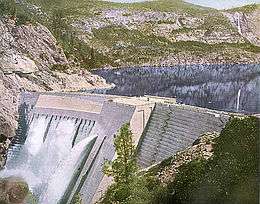
The vast Hetch Hetchy Project undertaking created the 360,000 acre feet (440,000,000 m3) Hetch Hetchy Reservoir, miles of tunnels, and a 150-mile (240 km) aqueduct to deliver the water and power lines to deliver electricity to the Bay Area. Of the many dams, reservoirs, and power plants, three were in the high country of Tuolumne County. The main dam was built in two phases. Large pipes called penstocks channeled water down the mountain to the main Moccasin Power hydroelectric plant completed in 1925 and rebuilt in 1968.
In 1923, the O'Shaughnessy Dam was completed to its initial height on the Tuolumne River, creating the Hetch Hetchy Reservoir. The dam was raised 65.5 feet (20.0 m) higher to its present 430 feet (130 m) height in 1939.[54] The dam and reservoir are the centerpiece of the Hetch Hetchy Project, which in 1934 began to deliver water 167 miles (269 km) west to San Francisco and its client municipalities in the greater San Francisco Bay Area.
Central Valley Project

Trinity Dam was the main storage feature of the Central Valley Project (CVP) proposal to divert water from the Trinity River in northwestern California to augment water supplies in the CVP service area. In 1948, the U.S. Bureau of Reclamation, which was responsible for the construction and operations of most CVP facilities, devised a plan of four dams and two tunnels to capture and store some of the flow of the Trinity River and transport it to the Sacramento River, generating a net surplus of hydroelectric power along the way. Trinity Dam was the main storage feature of the division, providing a stable flow to the Lewiston Dam, the diversion point for Trinity River waters into the Central Valley via the Trinity Tunnel.[55][56] Trinity Lake was completely filled with water from the Trinity River by 1963, becoming the third largest lake in California, with 145 miles (233 km) of shoreline.
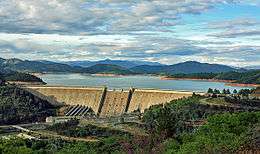
Shasta Dam is a concrete arch-gravity dam[57] across the Sacramento River in the northern part of California, at the north end of the Sacramento Valley. The dam mainly serves long-term water storage and flood control in its 4,500,000-acre-foot (5.6×109 m3) reservoir, Shasta Lake. The lake has 365 miles (587 km) of mostly steep mountainous shoreline covered with tall evergreen trees and manzanita. The lake's maximum depth is 517 feet (158 m). Water released from the lake generates hydroelectric power. At 602 feet (183 m) high, the dam is the ninth-tallest dam in the United States and forms the largest reservoir in California.
Shasta Dam was envisioned as early as 1919 because of frequent floods and droughts troubling California's largest agricultural region, the Central Valley. Shasta Dam was first authorized in the 1930s as a state undertaking. However, this coincided with the Great Depression, and building of the dam was transferred to the federal Bureau of Reclamation as a public works project. Construction started in earnest in 1937 under the supervision of Chief Engineer Frank Crowe. During its building, the dam provided thousands of much-needed jobs; it was finished 26 months ahead of schedule in 1945. When completed, the dam was the second-tallest in the United States after Hoover, and was considered one of the greatest engineering feats of all time.
Even before its dedication, Shasta Dam served an important role in World War II, providing electricity to California factories, and it still plays a vital part in the management of state water resources. However, it has brought about major changes to the environment and ecology of the Sacramento River, and met with controversy over its significant destruction of Native American tribal lands. In recent years, there has been debate over whether or not to raise the dam in order to allow for increased water storage and hydropower generation.
Pardee Dam is a 345-foot-high (105 m) structure across the Mokelumne River on the boundary between Amador and Calaveras counties, in the foothills of the Sierra Nevada approximately 30 miles (48 km) northeast of Stockton. The Pardee Reservoir impounds 210,000 acre feet (260,000,000 m3) of water when it is full.[58]
Construction on the Mokelumne Aqueduct and Pardee Dam began in 1926, and by 1929 the 345-foot-high (105 m) concrete arch Pardee Dam and the First Mokelumne Aqueduct, consisting of a single pipeline, were completed. The first deliveries to the Bay Area from the 210,000-acre-foot (260,000,000 m3) reservoir were made on June 23, 1929. At the time of completion, Pardee Dam was the tallest in the world (this record was surpassed one year later by Diablo Dam in Washington). In 1949, a second pipeline was built, and in 1963 the third pipeline was constructed, bringing the aqueduct to its present capacity.[59] In 1964, the second major dam and reservoir on the Mokelumne River, the Camanche Dam and 410,000-acre-foot (510,000,000 m3) Camanche Reservoir, were completed below Pardee. The Mokelumne Aqueduct and dam(s), run by the East Bay Municipal Utility District (EBMUD), is the primary water source for 35 communities in Alameda and Contra Costa counties, including Berkeley and Oakland. EBMUD holds water rights to almost all of the 30,000 acres (120 km2) in the Mokulumne River watershed and 25,000 acres (100 km2) in other watersheds. EBMUD also has an American River water right that could be sent to the Mokelumne Aqueduct through the Folsom South Canal.
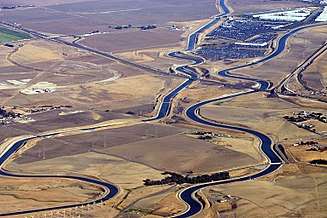
The California Aqueduct is a system of canals, tunnels, and pipelines that conveys water collected from the Sierra Nevada mountains and valleys of Northern and Central California to Southern California.[60] The Department of Water Resources (DWR) operates and maintains the California Aqueduct, including the two largest pumped-storage hydroelectric plants in California, Castaic and Gianelli. Gianelli is located at the base of San Luis Dam, which forms San Luis Reservoir, the largest off-stream reservoir in the United States. The Castaic Power Plant is located at the northern end of Castaic Lake, while Castaic Dam is located at the southern end.
The aqueduct begins at the Sacramento–San Joaquin River Delta at the Banks Pumping Plant, which pumps from the Clifton Court Forebay. Water is pumped by the Banks Pumping Plant to the Bethany Reservoir, which serves as a forebay for the South Bay Aqueduct via the South Bay Pumping Plant. From the Bethany Reservoir, the aqueduct flows by gravity approximately 60 miles (97 km) to the O'Neill Forebay at the San Luis Reservoir. From the O'Neill Forebay, it flows approximately 16 miles (26 km) to the Dos Amigos Pumping Plant. After Dos Amigos, the aqueduct flows about 95 miles (153 km) to where the Coastal Branch splits from the "main line". The split is approximately 16 miles (26 km) south-southeast of Kettleman City. After the Coastal Branch, the line continues by gravity another 66 miles (106 km) to the Buena Vista Pumping Plant. From the Buena Vista, it flows approximately 27 miles (43 km) to the Teerink Pumping Plant. After Teerink it flows about 2.5 miles (4.0 km) to the Chrisman Pumping Plant. Chrisman is the last pumping plant before the Edmonston Pumping Plant, which is 13 miles (21 km) from Chrisman. South of the plant the west branch splits off in a southwesterly direction to serve the Los Angeles Basin. At the Edmonston Pumping Plant it is pumped 1,926 feet (587 m) over the Tehachapi Mountains.[61]
Water flows through the aqueduct in a series of abrupt rises and gradual falls. The water flows down a long segment, built at a slight grade, and arrives at a pumping station powered by Path 66 or Path 15. The pumping station raises the water, where it again gradually flows downhill to the next station. However, where there are substantial drops, the water's potential energy is recaptured by hydroelectric plants. The initial pumping station fed by the Sacramento River Delta raises the water 240 ft (73 m), while a series of pumps culminating at the Edmonston Pumping Plant raises the water 1,926 ft (587 m) over the Tehachapi Mountains. The Edmonston Pumping station requires so much power that several power lines off Path 15 and Path 26 are needed to ensure proper operation of the pumps.
A typical section has a concrete-lined channel 40 feet (12 m) at the base and an average water depth of about 30 feet (9.1 m). The widest section of the aqueduct is 110 feet (34 m), and the deepest is 32 feet (9.8 m). Channel capacity is 13,100 cubic feet per second (370 m3/s), and the largest pumping plant capacity at Dos Amigos is 15,450 cubic feet per second (437 m3/s).
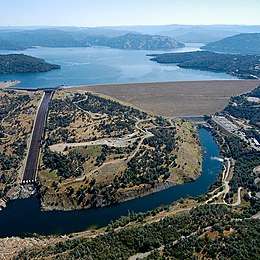
The California State Water Project, commonly known as the SWP, is a water management project under the supervision of the California Department of Water Resources. The SWP is the world's largest publicly built and operated water and power development and conveyance system, providing drinking water for more than 23 million people and generating an average of 6,500 GWh of hydroelectricity annually. However, as the largest single consumer of power in the state, its net output in an "average" rainfall year is 5,100 GWh.[62]
The SWP collects water from rivers in Northern California and redistributes it to the water-scarce but populous south through a network of aqueducts, pumping stations and hydroelectric plants. About 70% of the water provided by the project is used for urban areas and industry in Southern California and the San Francisco Bay Area, and 30% is used for irrigation in the Central Valley.[63] To reach Southern California, the water must be pumped 2,000 feet (610 m) over the Tehachapi Mountains—the highest single water lift in the world.[64] The SWP shares many facilities with the federal Central Valley Project (CVP), which primarily serves agricultural users. Water can be interchanged between SWP and CVP canals as needed to meet peak requirements for project constituents. The SWP provides estimated annual benefits of $400 billion to California's economy.[65]
Since its inception in 1960, the SWP has required the construction of 21 dams and more than 700 miles (1,100 km) of canals, pipelines and tunnels,[66] although these constitute only a fraction of the facilities originally proposed. As a result, the project has only delivered an average of 2.4 million acre feet (3.0 km3) annually, as compared to total entitlements of 4.23 million acre feet (5.22 km3). Environmental concerns caused by the dry-season removal of water from the Sacramento–San Joaquin River Delta, a sensitive estuary region, have often led to further reductions in water delivery. Work continues today to expand the SWP's water delivery capacity while finding solutions for the environmental impacts of water diversion.
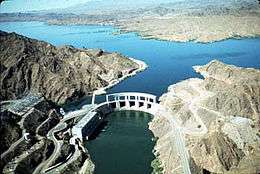
The Colorado River Aqueduct, or CRA, is a 242-mile (389 km) water conveyance in Southern California, operated by the Metropolitan Water District of Southern California (MWD). The aqueduct impounds water from the Colorado River at Lake Havasu on the California–Arizona border. This water is then transferred west by pumping stations, reservoirs, and canals across the Mojave and Colorado deserts to the east side of the Santa Ana Mountains. It is one of the primary sources of drinking water for Southern California.
Originally conceived by William Mulholland and designed by Chief Engineer Frank E. Weymouth of the MWD, it was the largest public works project in southern California during the Great Depression. The project employed 30,000 people over an eight-year period and as many as 10,000 at one time.[67]
The system is composed of two reservoirs, five pumping stations, 63 miles (101 km) of canals, 92 miles (148 km) of tunnels, and 84 miles (135 km) of buried conduit and siphons. Average annual throughput is 1,200,000 acre feet (1.5 km3).[67]
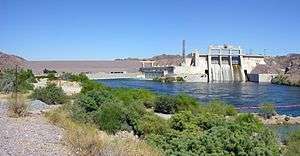
Davis Dam is located on the Colorado River about 70 miles (110 km) downstream from Hoover Dam. Davis Dam stretches across the border between Arizona and Nevada and impounds the Colorado River to form Lake Mohave. The United States Bureau of Reclamation owns and operates the dam, which was completed in 1951. Davis Dam is a zoned earth fill dam with a concrete spillway, 1,600 feet (490 m) in length at the crest, and 200 feet (61 m) high. The earth fill dam begins on the Nevada side, but it does not extend to the Arizona side. Instead, there is an inlet formed by earth and concrete. At the end of the inlet is the spillway. The power plant is on the Arizona side of the inlet, perpendicular to the dam. This is a very unusual design. The hydroelectric plant generates between 1 and 2 terawatt-hours of electricity annually. The plant has a capacity of 251 MW (337,000 hp), and the tops of its five Francis turbines are visible from outside the plant. The plant's hydraulic head is 136 feet (41 m). The dam's purpose is to generate hydroelectricity and regulate water releases into the Colorado River for use downstream by California, Arizona and Mexico.
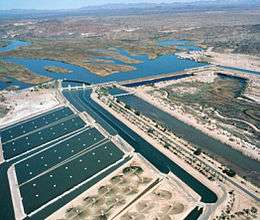
Imperial Dam is a concrete slab and buttress, ogee weir structure across the Colorado River on the California–Arizona border, 18 miles (29 km) northeast of Yuma. Completed in the 1938, the dam retains the waters of the Colorado River in the Imperial Reservoir before desilting and diversion into the All-American Canal, the Gila River, and the Yuma Project aqueduct. Between 1932 and 1940, the Imperial Irrigation District relied on the Inter-California Canal, the Imperial Canal, and the Alamo River.
Imperial Dam was built to replace the Laguna Diversion Dam, built in 1901–1915, which was the first dam and reclamation project on the Colorado River. Imperial Dam was built with three sections; the gates of each section hold back the water to help divert the water towards the desilting plant. Three giant desilting basins and 72 770-foot (230 m) scrapers hold and desilt the water; the removed silt is carried away by six sludge pipes running under the Colorado River that dump the sediment into the California sluiceway, which returns the silt to the Colorado River. The water is now directed back towards one of the three sections which divert the water into one of the three channels. About 90% of the volume of the Colorado River is diverted into the canals at this location. Diversions can top 40,000 cubic feet (1,100 m3) per second—more than 50 times the flow of the Rio Grande.
The Gila River and the Yuma Project aqueduct branch off toward Arizona, while the All-American Canal branches southwards for 37 miles (60 km) before reaching its headworks on the California border and bending west toward the Imperial Valley.
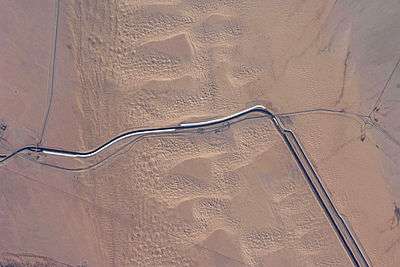
The All-American Canal is an 80-mile-long (130 km) aqueduct in southeastern California. It conveys water from the Colorado River into the Imperial Valley and to nine cities. It is the Imperial Valley's only water source, and replaced the Alamo Canal, which was located mostly in Mexico. The Imperial Dam, about 30 miles (48 km) northeast of Yuma, Arizona, on the Colorado River, diverts water into the All-American Canal, which runs to just west of Calexico, California, before its last branch heads mostly north into the Imperial Valley. Five smaller canals branching off the All-American Canal move water into the Imperial Valley. These canal systems irrigate up to 630,000 acres (250,000 ha) of good cropland and have made possible a greatly increased crop yield in this area, originally one of the driest on earth. It is the largest irrigation canal in the world, carrying a maximum of 26,155 cubic feet per second (740.6 m3/s). Agricultural runoff from the All-American Canal drains into the Salton Sea. The All-American Canal runs parallel to the Mexico–United States border for several miles.
The Sacramento Deep Water Ship Channel (also known as the "Sacramento River Deep Water Ship Channel" or "SRDWSC") is a canal from the Port of Sacramento to the Sacramento River, which flows into San Francisco Bay. It was completed by the United States Army Corps of Engineers in 1963. The channel is about 30 feet (9.1 m) deep, 200 feet (61 m) wide, and 43 miles (69 km) long.
The Port of Sacramento has always been a significant port on the West Coast of the United States since the 1849 California Gold Rush. It was originally served primarily by paddle steamers which carried cargo from San Francisco Bay up the Sacramento River to Sacramento. Today it receives far less traffic than larger ports and handles primarily agricultural products and other bulk goods rather than containers, which now dominate the shipping market.
Other engineering feats were the building of Hoover Dam, which though in Nevada, provides power and water to Southern California.
Another project was the draining of Tulare Lake, which during high water was the largest freshwater lake fully inside an American state. This created a large wet area amid the dry San Joaquin Valley, and swamps abounded at its shores. By the 1970s, it was completely drained, but it attempts to resurrect itself during heavy rains.
Water recycling
The recycling of treated municipal wastewater has become a significant part of California's water supply. The different water agencies in California were recycling over 770,000 acre feet (950,000,000 m3) as of 2009, the date of the last survey. Some of the many uses for recycled water are: golf course irrigation 7%, landscape irrigation 17%, agricultural irrigation 37%, commercial reuse of water 7%, industrial uses 7%, geothermal energy production 1%, seawater intrusion barrier via fresh water injections 7%, groundwater recharge by well injection and flotation ponds 12%, recreational impoundments 4%, and natural wetland systems/restoration 4%.[68] The stated goal is the recycling of 1,600,000 acre feet (2.0×109 m3) of treated municipal wastewater.
On March 14, 2014, the State Water Board approved $800 million in financial incentives for recycled water projects.[69] These projects typically take years to get approved and built.
The Water Replenishment District of Southern California (WRD), in service since 1959, is one of the more aggressive agencies that use recycled water for their groundwater replenishment and seawater intrusion barriers.[70] To prevent seawater contamination of their groundwater, they have several sets of injection wells that inject clean water between their aquifer and the sea. This creates a local water barrier to seawater intrusion. The other mechanism is to make sure the water level is above sea level.
Well users, including municipal water users, in the WRD area pump about 250,000 acre feet (310,000,000 m3) of water per year out of their aquifer. This is an "overdraft" of about 150,000 acre feet (190,000,000 m3) of water over what their underground aquifer can "normally" refill. To replace this "overdraft" of water into the aquifer, they have flotation ponds that catch rain runoff water, and supplement with other water they either buy or recycle, then let the water soak into the ground (spreading water) to help replenish the water in the aquifer(s). In addition they buy Colorado River water that is shipped via the Colorado River Aqueduct, and they accept part of the treated municipal wastewater of the about 4,000,000 people in their district and treat it to additional purity and sanitation levels by using reverse osmosis and advanced filtering. Their largest tertiary water treatment facility is the Leo J. Vander Lans Advanced Water Treatment facility. The water out of this facility is better than the water that comes out of the "average" municipal water treatment facility. To finance their water recycling projects WRD charges $268 per acre-foot of water pumped out, which generates about $65,000,000/year.[71] WRD is now on a project (WIN) to enlarge their water treatment facilities to take larger quantities of treated municipal wastewater and treat enough of it that they will not have to buy Colorado River water. Overall it is estimated that this project provides over 40% of the water used in the Southern California district served by the WRD.
Among the many water recycling projects just being completed, the South Bay Water Recycling program distributes recycled water to more than 400 customers in the San Jose, area for irrigation, industrial and other purposes. In Northern California, two agencies have teamed up to develop the San Ramon Valley Recycled Water Program. Jointly sponsored by the Dublin San Ramon Services District and the East Bay Municipal Utility District, the program will provide recycled water to municipal parks, golf courses, business parks, greenbelts and roadways. The Irvine Ranch Water District has built a dual water system, which supplies recycled water to commercial high rises for use in flushing toilets and urinals. A West Basin Municipal Water District project distributes recycled water to more than 85 customers, including Chevron and Mobil refineries. Monterey County Water Recycling Projects provide recycled water for agricultural irrigation to help ease demands on an overused groundwater aquifer. The Padre Dam Water Recycling Facility was expanded to recycle 2 million gallons/day for turf irrigation at parks, golf courses and other commercial and industrial facilities.
In the San Diego region, 16 water agencies are planning to use over 32,300 acre feet (39,800,000 m3) of recycled water per year in order to meet the region's water supply demand. The city of Carlsbad's new recycled water treatment and distribution system will deliver approximately 3,000 acre feet (3,700,000 m3)} per year of recycled water to customers located in that community. In the southern portion of San Diego County, the Otay Water District is constructing a distribution system to deliver an estimated 5,000 acre feet (6,200,000 m3) per year of recycled water by 2030 purchased from the city of San Diego's South Bay Water Recycling Plant. In Southern California, the Elsinore Valley Municipal Water District is using recycled water to help replenish and enhance Lake Elsinore.
The Orange County Sanitation and Orange County Water Districts are planning for treated wastewater, currently discharged into the ocean, to undergo microfiltration, reverse osmosis and ultraviolet disinfection. The purified water will be equivalent in quality to distilled water and exceed all state and federal drinking water standards. The purified water will be pumped to spreading ponds near the Santa Ana River for percolation into the groundwater basin, with some injected through injection wells along the coast as a barrier to seawater intrusion. Like the WRD projects in Southern California, the Orange County Water District has amassed a long record of successfully recycling water with its Water Factory 21.[72]
Desalination projects
On December 24, 2012, the San Diego County Water Authority announced they had sold $734 million worth of tax-free bonds at 4.38% interest to build the Carlsbad Seawater Desalination Project, the largest seawater desalination plant in the Western Hemisphere. The project is located near the Encina Power Station in Carlsbad, and is expected to produce about 56,000 acre feet (69,000,000 m3) of water per year by 2016 when the project is completed. The plant is expected to use over 17,000 reverse osmosis racks. The project includes $80 million in San Diego Water Authority upgrades to its own facilities. A 10-mile (16 km) pipeline is being built to deliver desalinated water into its Twin Oaks Valley Water Treatment Plant near San Marcos. The developer Poseidon Resources is building the plant and pipeline in a joint venture with contractor Kiewit Shea Desalination. The project will deliver up to 50 million gallons a day of drought-proof, highly reliable water that will become a core, day-to-day resource for the region. It is projected to meet about 7% of San Diego County's demand in 2020. The total cost is projected at $1,849 to $2,257 per acre-foot.[73][74] The additional cost of desalinating seawater will add $5 to $7 per month to ratepayers' bills—about a 10% increase.
The present (2014) drought has brought reconsideration of the Charles Meyer Desalination Facility that was built for $34 million in the early 1990s in Santa Barbara but was later essentially mothballed when the drought was over. There are early discussions about investing around $20 million more to upgrade and restart the desalination plant. They have permits to make about 3,000 acre feet (3,700,000 m3) of desalinated water per year, but they will incur additional costs to pump their desalinated water to existing higher elevation reservoirs if they reactivate the plant. The projected costs (2014) were about $3,000 per acre foot.
The small city of Sand City, located on the Monterey Peninsula, struck out on its own in 2007 to develop a small desalination plant. The city partnered with California American Water for the $14 million project, which started producing 300 acre feet of freshwater a year in 2010. The cost and water are shared with other nearby small communities.[75]
California Department of Water Resource data
The web site run by the California Department of Water Resources lists the present reservoir storage levels for each of California's major reservoirs.[76] Individual reservoir capacities and percent of full are given for the major reservoirs. As of April 3, 2014, they had 12,682,744 acre feet (1.5643934×1010 m3) of water stored, or about 65% of the 19,490,257 acre feet (2.4040878×1010 m3) of water they usually would have at that time of year.
California's highway system

Automobile travel became important after 1910 when motor cars and trucks began to become common. Before that nearly all long-distance travel was by railroad or stagecoach, with horse- or mule-drawn wagons hauling the freight. A key route was the Lincoln Highway, which was America's first transcontinental road for motorized vehicles, connecting New York City to San Francisco. The creation of the Lincoln Highway in 1913 was a major stimulus on the development of both industry and tourism in the state. Similar effects occurred in 1926 with the creation of Route 66. The last large addition to the state highway system was made by the California State Assembly in 1959, after which only minor changes have been made. Most new highway construction was then done on the Interstate Highway System started under President Dwight D. Eisenhower, who championed its formation.
The first state road was authorized on March 26, 1895, when a law created the post of "Lake Tahoe Wagon Road Commissioner" to maintain the Lake Tahoe Wagon Road (the 1852 Johnson's Cut-off of the California Trail), now US 50 from Smith Flat, 3 miles (5 km) east of Placerville, to the Nevada state line.[77] The 58-mile (93 km) road had been operated as a privately owned toll road from about 1855 till 1886, when El Dorado County bought it; the county deeded the road to the state on February 28, 1896.[78] Funding initially was only enough for minimal improvements, including a stone bridge over the South Fork American River in 1901.[79]
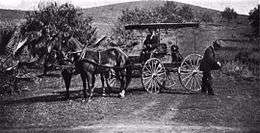
Also in 1895, on March 27 the legislature created the three-person Bureau of Highways to coordinate efforts by the counties to build good roads. The bureau traveled to every county of the state in 1895 and 1896 and prepared a map of a recommended system of state roads, which they submitted to the governor on November 25, 1896.[80] The legislature replaced the Bureau of Highways with the Department of Highways on April 1, 1897,[81] three days after it passed a law creating a second state highway from Sacramento to Folsom – another part of what became US 50 – to be maintained by three "Folsom Highway Commissioners".[82] This was the last highway maintained by a separate authority, as the next state road, the Mono Lake Basin State Road (now part of SR 120), was designated by the legislature in 1899 to be built and maintained by the Department of Highways.[83] Construction of a large connected system began in 1912, after the state's voters approved an $18 million bond issue for over 3,000 miles (4,800 km) of highways. The Lincoln Highway when it was set up in 1913 used the Lake Tahoe Wagon Road (the 1852 Johnson's Cut-off of the California Trail), now US 50, to get over the Sierra Nevada.
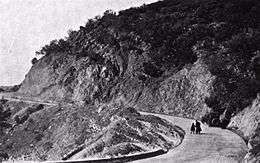
Several more state highways were legislated in the next decade, and the legislature passed a law creating the Department of Engineering on March 11, 1907. This new department, in addition to non-highway duties, was to maintain all state highways, including the Lake Tahoe Wagon Road.[84] On March 22, 1909, the "State Highways Act" was passed, taking effect on December 31, 1910, after a successful vote by the people of the state in November. This law authorized the Department of Engineering to issue $18 million in bonds for a "continuous and connected state highway system" that would connect all county seats.[85] To this end, the department created the three-member California Highway Commission on August 8, 1911, to take full charge of the construction and maintenance of this system. As with the 1896 plan by the Bureau of Highways, the Highway Commission traveled the state to determine the best routes,[86] which ended up stretching about 3,100 miles (5,000 km).[87] Construction began in mid-1912,[88] with groundbreaking on Contract One – now part of SR 82 in San Mateo County – on August 7.[89] Noteworthy portions of the system built by the commission included the Ridge Route in southern California and the Yolo Causeway west from Sacramento.[90]
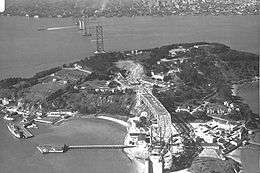
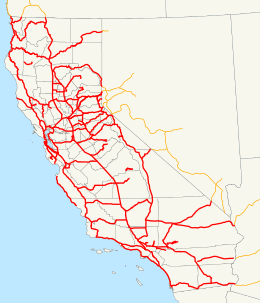
Because the first bond issue did not provide enough funding, the "State Highways Act of 1915" was approved by the legislature on May 20, 1915, and the voters in November 1916, taking effect on December 31. This gave the Department of Engineering an additional $12 million to complete the original system and $3 million for a further approximately 680 miles (1,090 km) specified by the law. At this time, each route was assigned a number from 1 to 34;[91] this system of labeling routes, although never marked with signs, remained until the 1964 renumbering. In 1917, the legislature gave the California Highway Commission statutory recognition, and turned over the approximately 750 miles (1,210 km)[92] of roads adopted by legislative act, until then maintained by the State Engineer, to the commission.[88] Where not serving as extensions of existing routes, these – and routes subsequently added legislatively in 1917 and 1919 – were given numbers from 35 to 45. A third bond issue was approved by the voters at a special election on July 1, 1919, and provided $20 million more for the existing routes and the same amount for new extensions totaling about 1,800 miles (2,900 km), adding Routes 46 to 64 to the system.[93] The three bond issues together totaled 5,560 miles (8,950 km), of which just over 40% (60% if the 1919 bond issue is left out) was completed or under construction in mid-1920.[94]
The Department of Engineering became part of the new Department of Public Works in 1921, and the California Highway Commission was entirely separated as its own department in 1923.[95] In order to pay for the roads, a 2-cent per gallon gasoline tax was approved in 1923.[95] The legislature continued to add highways to the system, including the Mother Lode Highway (now part of SR 49) in 1921[96] and the Arrowhead Trail (now I-15 north of Barstow) in 1925.[97] In January 1928, the California State Automobile Association and Automobile Club of Southern California, which had already been placing guide and warning signs along state highways, marked the U.S. Highways along several of the most major state highways.[98] The California Toll Bridge Authority was created in 1929 to acquire and operate all toll bridges on state highways,[95] including the San Francisco–Oakland Bay Bridge and Carquinez Bridge.
After 1927 and 1929, in which no highways were added to the system, the legislature authorized the construction of 23 new routes in 1931,[99] which were numbered from 72 to 80 when not forming extensions of existing routes. Two years later, another 213 sections of highway were added,[100] almost doubling the total length of state highways to about 14,000 miles (23,000 km);[101] the last-assigned route number jumped from 80 to 202. Many of these new routes, as well as a number of existing routes, were incorporated into the initial system of state sign routes in 1934, also posted by the auto clubs.[95][102]
The Division of Highways took over signage on state highways from the auto clubs in 1947,[95] though at least the Auto Club of Southern California continued to place signs on city streets until 1956.[103]
Movies, radio and TV
The first decades of the twentieth century saw the rise of the film studio system. MGM, Universal and Warner Brothers all acquired land in Hollywood, which was then a small subdivision known as "Hollywoodland" on the outskirts of Los Angeles. The enormous variety in terrain and the year-round sunshine made filmmaking easier and cheaper, and actors, producers, financiers and craftsmen headed to Hollywood.
The movies made California even better known, attracting hundreds of thousands of migrants, especially from the Midwest, who loved the mild Mediterranean climate, cheap land, and new jobs.
By the 1930s, Hollywood had extended its reach into radio, and by 1950 Southern California had also become a major center of television production, hosting studios for major networks such as NBC and CBS.
California aerospace and shipping
California aerospace history
In 1883–1886, John J. Montgomery began experimenting with gliders. He made the first controlled flights in a heavier-than-air flying machine in America. Montgomery was killed in 1911 in a glider-related accident.[104]
After Wilbur and Orville Wright demonstrated the feasibility of controlled manned flight, Glenn Curtiss entered the field, focusing on aircraft manufacturing and pilot training. Part of this training was done in California.
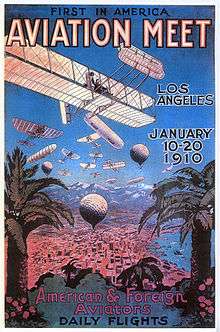
The Los Angeles International Air Meet (January 10 to January 20, 1910) was among the earliest air shows in the world and the first major air show in the United States.[105] It was held in Los Angeles County at Dominguez Field in present-day Compton.[106] Spectator turnout numbered approximately 254,000 over 11 days of ticket sales.[107] The Los Angeles Times called it "one of the greatest public events in the history of the West."[108]
On November 29, 1910, Glenn H. Curtiss wrote to Secretary of the Navy George von L. Meyer offering flight instruction without charge for one Navy officer as one means of assisting "in developing the adaptability of the aeroplane to military purposes." In the winter of 1910, Glenn Curtiss established a private flying school on North Island, on land obtained through the cooperation of the Aero Club of San Diego. He soon invited the Army and Navy to send officers to receive free instruction as "aeroplane pilots". On December 23, 1910, Lieut. T. Gordon "Spuds" Ellyson was ordered to report to the Glenn Curtiss Aviation Camp at North Island in San Diego. He completed his training April 12, 1911, and became Naval Aviator No. 1. The original site of this winter encampment is now part of Naval Air Station North Island in San Diego and is referred to by the Navy as "The Birthplace of Naval Aviation".
On January 18, 1911, at 11:01 a.m., Eugene Ely, flying a Curtiss pusher, landed on a specially built platform aboard the armored cruiser USS Pennsylvania at anchor in San Francisco Bay. At 11:58 a.m., he took off and returned to Selfridge Field, San Francisco.[109]
Caltech in Pasadena provided an ideal situation for the development and manufacture of aircraft. In 1925, aircraft builder Donald Douglas and Los Angeles Times publisher Harry Chandler worked together with Caltech president Robert Millikan to bring a state-of-the-art aeronautical research laboratory to the Pasadena college. Douglas recruited some of Caltech's best and brightest students for his company. Douglas utilized the lab's wind tunnel and research staff while designing his DC-1, 2, and 3. In this way, the DC-3, undoubtedly one of the most successful aircraft designs ever built, represented more than just a single designer's project. It was a regional product, the result of an alliance of business and science created over the preceding five decades.
The Caltech Jet Propulsion Laboratory (JPL) traces its beginnings to 1936 in the Guggenheim Aeronautical Laboratory at the California Institute of Technology (GALCIT), when the first set of rocket experiments were carried out in the Arroyo Seco. Caltech graduate students Frank Malina, Weld Arnold, Apollo M. O. Smith, and Tsien Hsue-shen, along with Jack Parsons and Edward S. Forman, tested a small, alcohol-fueled motor to gather data for Malina's graduate thesis. Malina's thesis adviser was engineer-aerodynamicist Theodore von Kármán, who eventually arranged for United States Army financial support for this "GALCIT Rocket Project" in 1939. In 1941, Malina, Parsons, Forman, Martin Summerfield, and pilot Homer Bushey demonstrated the first jet-assisted takeoff rockets (JATO units) to the Army. In 1943, von Kármán, Malina, Parsons, and Forman established the Aerojet Corporation to manufacture JATO motors. The project took on the name Jet Propulsion Laboratory in November 1943, formally becoming an Army facility operated under contract by the university.[110][111][112][113]
During JPL's Army years, the laboratory developed two deployed weapon systems, the MGM-5 Corporal and MGM-29 Sergeant intermediate range ballistic missiles, the first US ballistic missiles developed at JPL.[114] It also developed a number of other weapons system prototypes, such as the Loki anti-aircraft missile system, and the forerunner of the Aerobee sounding rocket. At various times, it carried out rocket testing at the White Sands Proving Ground, Edwards Air Force Base, and Goldstone, California. A lunar lander was also developed in 1938–39 which influenced design of the Apollo Lunar Module in the 1960s.[113]
In 1954, JPL teamed up with Wernher von Braun's rocketeers at the Army Ballistic Missile Agency's Redstone Arsenal in Huntsville, Alabama, to propose orbiting a satellite during the International Geophysical Year. The team lost that proposal to Project Vanguard, and instead embarked on a classified project to demonstrate ablative re-entry technology using a Jupiter-C rocket. They carried out three successful sub-orbital flights in 1956 and 1957. Using a spare Jupiter-C, the two organizations then launched America's first satellite, Explorer 1, on February 1, 1958.[111][112]
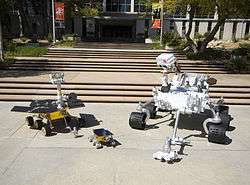
JPL was transferred to NASA in December 1958,[115] becoming the agency's primary planetary spacecraft center. JPL engineers designed and operated Ranger and Surveyor missions to the Moon that prepared the way for the Apollo program. JPL also led the way in interplanetary exploration with the Mariner missions to Venus, Mars, and Mercury.[111] In 1998, JPL opened the Near-Earth Object Program Office for NASA;[116] as of 2013, it has found 95% of asteroids that are a kilometer or more in diameter that cross Earth's orbit.[117]
In 1940, 65% of aircraft manufacturers were located along or near the East or West Coasts of the United States. California alone had 44 percent of all aircraft manufacturing. In 1944, 12 states shared 85 percent of airframe floor space, and California's percentage had dropped to 24%. Engine and propeller manufacturing had also decentralized. Most wartime expansion took place inland due to concerns over possible coastal attacks. After the war, massive layoffs occurred as wartime orders were cancelled.[118]
Major manufacturers of aircraft in California were/are Douglas Aircraft Company, Lockheed Corporation, Boeing, Hughes Aircraft, Glenn L. Martin Company, North American Aviation, Northrop Corporation, Vultee, and many others.[119] Many of these early companies would disappear or consolidate with other companies. However, a few would grow to become giants in the industry.[120]
Notable California aircraft
Gallery of aircraft and spacecraft built and developed (wholly or in part) in California. Many more could be included.
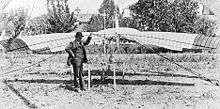 Montgomery's The Santa Clara glider 1905
Montgomery's The Santa Clara glider 1905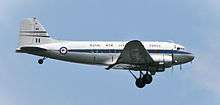 Douglas DC-3 1936
Douglas DC-3 1936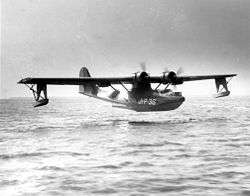
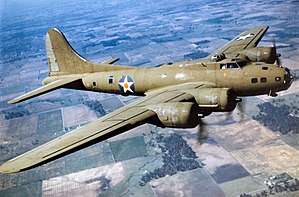

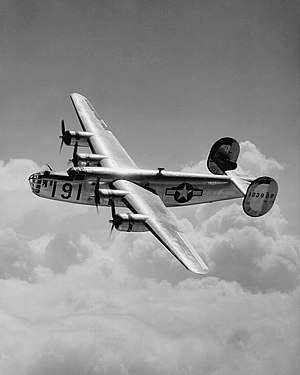
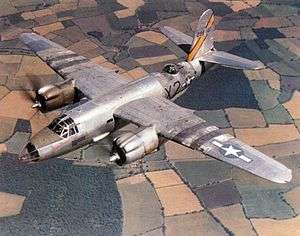 Martin B-26 Marauder 1940
Martin B-26 Marauder 1940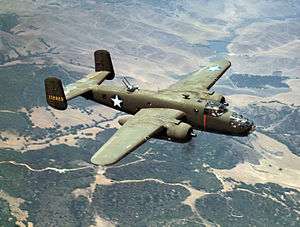
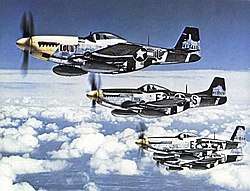
.jpg)
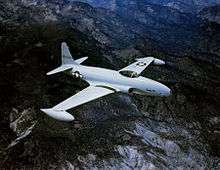
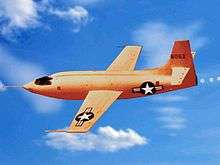 Bell X-1 1946
Bell X-1 1946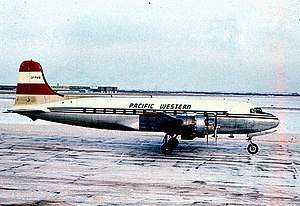 Douglas DC-4 1947
Douglas DC-4 1947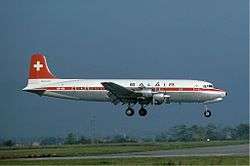 Douglas DC-6 1947
Douglas DC-6 1947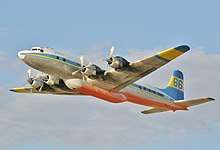 Douglas DC-7 1953
Douglas DC-7 1953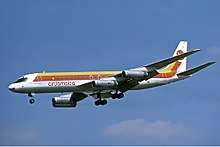 Douglas DC-8 1958
Douglas DC-8 1958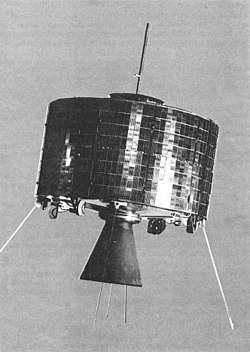 Syncom communications satellite 1963
Syncom communications satellite 1963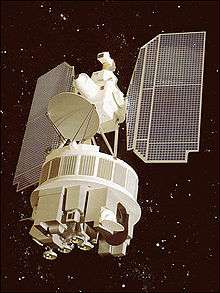 Nimbus program weather satellite 1964
Nimbus program weather satellite 1964.jpg) Intelsat I 1965
Intelsat I 1965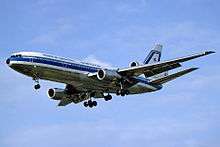
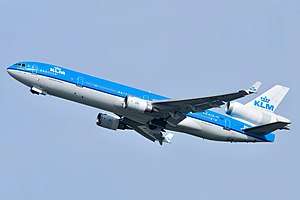
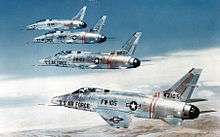
_in_flight_with_full_bomb_load_060901-F-1234S-013.jpg)
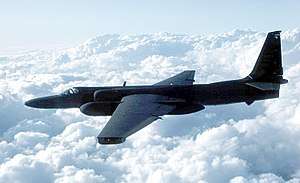 Lockheed U-2 1957
Lockheed U-2 1957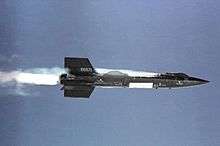 North American X-15 1959
North American X-15 1959

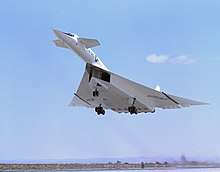
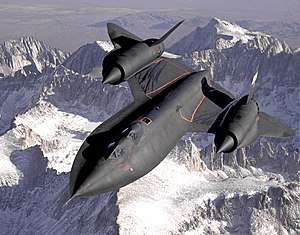
.jpg) Douglas A-4 Skyhawk 1966
Douglas A-4 Skyhawk 1966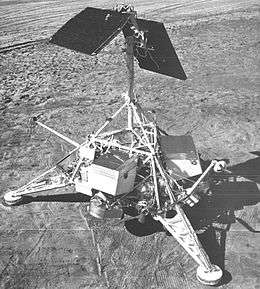 Surveyor 1 1966
Surveyor 1 1966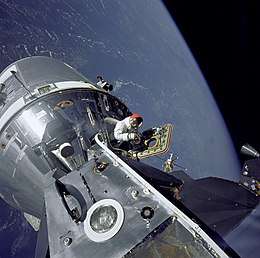 Apollo 9 1969
Apollo 9 1969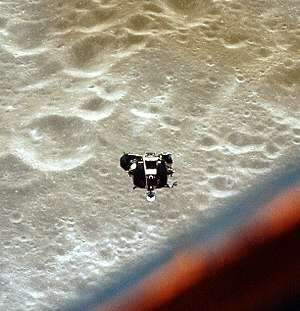 Apollo 10 1969
Apollo 10 1969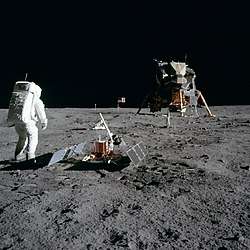 Apollo 11 1969
Apollo 11 1969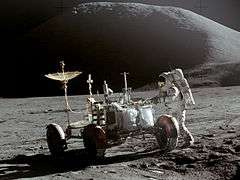 Apollo 15 1970
Apollo 15 1970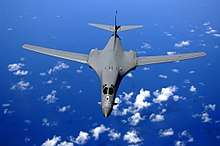 Rockwell B-1 Lancer 1974
Rockwell B-1 Lancer 1974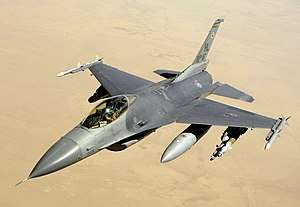
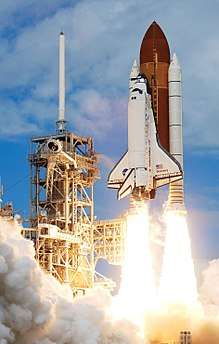 Space Shuttle 1981
Space Shuttle 1981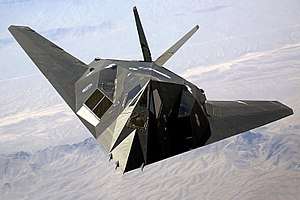 Lockheed F-117 Nighthawk stealth bomber 1985
Lockheed F-117 Nighthawk stealth bomber 1985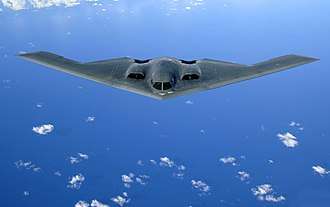
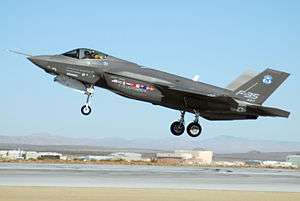
California aerospace museums
- Aerospace Museum of California, Sacramento
- Air Force Flight Test Center Museum, Edwards Air Force Base[121]
- Blackbird Airpark, Palmdale[122]
- Burbank Aviation Museum, Burbank,[123] displays of local aviation history
- California Science Center, Los Angeles
- Castle Air Museum, Atwater, adjacent to the former Castle Air Force Base[124]
- Classic Rotors Museum, Ramona
- Commemorative Air Force Southern California Wing, Camarillo Airport, Camarillo
- Dryden Flight Research Center Visitor Facility, Edwards Air Force Base near Palmdale
- Estrella Warbird Museum, Paso Robles
- Flight Path Learning Center & Museum, Los Angeles International Airport, Los Angeles
- Flying Leatherneck Aviation Museum, Marine Corps Air Station Miramar, San Diego
- Gillespie Field, El Cajon
- Hiller Aviation Museum, San Carlos
- Jimmy Doolittle Air & Space Museum, Travis Air Force Base, Fairfield
- Joe Davies Heritage Airpark, at Plant 42, Palmdale[125]
- Lyon Air Museum, Santa Ana[126]
- March Field Air Museum, Riverside
- Milestones of Flight Museum, Lancaster
- Museum of Flying, Santa Monica
- NASA Ames Exploration Center, Mountain View
- Oakland Aviation Museum, Oakland
- Pacific Coast Air Museum, Santa Rosa
- Palm Springs Air Museum, Palm Springs
- Planes of Fame, Chino
- Point Mugu Missile Park,[127] Navy Base Ventura County, at Point Mugu[128]
- Planes of Fame, Chino
- Proud Bird Restaurant and Museum, Los Angeles[129][130][131]
- Ronald Reagan Presidential Library, Simi Valley
- San Diego Air & Space Museum, located at Balboa Park (San Diego) in San Diego
- San Diego Aircraft Carrier Museum, also called the USS Midway Museum, Navy Pier, San Diego
- Santa Maria Museum of Flight, Santa Maria[132]
- Saxon Aerospace Museum, Boron[133]
- USS Hornet Museum, Alameda
- U.S. Naval Museum of Armament and Technology, China Lake[134]
- Vandenberg Air Force Base, Santa Barbara County
- Western Museum of Flight, Torrance
- Yanks Air Museum, Chino
- Yanks Air Museum Annex, Greenfield[135][136]
During World War II, California's mild climate became a major resource for the war effort. Numerous air-training bases were established in Southern California, where most aircraft manufacturers, including Douglas Aircraft and Hughes Aircraft, expanded or established factories. Major naval shipyards were established or expanded in San Diego, Long Beach, and Mare Island in San Francisco Bay.
California shipping
Kaiser–Permanente California shipyards
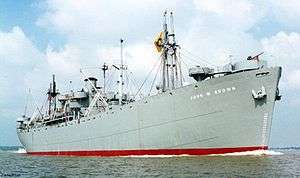
The four Richmond Shipyards, located in the city of Richmond, California, were run by Permanente Metals and Kaiser Shipyards. The Richmond yards were responsible for constructing more Liberty ships during World War II (747) than any other shipyard in the United States. Liberty ships were chosen for mass production because their somewhat obsolete design was relatively simple and their triple expansion piston steam engine components were simple enough that they could be made by several companies that were not highly needed to manufacture other parts. Ship building was given a high priority for steel and other needed components, as the German U-boats until 1944 sunk more ships than could be built by all the shipyards in the United States. The United States shipyards built about 5,926 ships in World War II[137] plus over 100,000 more smallcraft made for the U.S. Army naval components.
Henry J. Kaiser's company had been building cargo ships for the U.S. Maritime Commission in the late 1930s. In 1940 orders for ships from the British government, already at war with Nazi Germany, allowed for growth. Kaiser established his first Richmond shipyard beginning in December 1940, eventually building three more in Richmond; each yard with four to eight slips to build ships. Kaiser-Permanente specialized in mass-producing Liberty ships quickly and efficiently, and that was all they built until 1944, when they switched to the much more complicated Victory ships and built some tugs and Landing Ship, Tank (LSTs) and other specialized ships in the newly built Yard #4.
747 EC2-S-C1 Liberty ship cargo transports were built. The following references list individual ships built:
- Kaiser Permanente Yard #1; Oceans, Libertys, Victorys; built in Richmond[138]
- Kaiser Permanente Yard #2; Libertys, Victorys built in Richmond[139]
- Kaiser Permanente Yard #3; Libertys, Victorys; built in Richmond[140]
- Kaiser Permanente Yard #4; Landing Ship, Tanks (LST)s, Tugs; built in Richmond[141]
- Kaiser, California Shipbuilding; Libertys, Victorys; built in Los Angeles[142]
These Liberty ships were completed in two-thirds the amount of time and at a quarter of the cost of the average of all other shipyards. The Liberty ship SS Robert E. Peary was assembled in less than five days as a part of a special competition among shipyards; but by 1944 it was only taking the astonishingly brief time of a little over two weeks to assemble a Liberty ship by standard methods. They pre-assembled major parts of the ship including the hull sections at various locations in the shipyard and then, when needed, moved them with heavy lift cranes to the shipyard launching site, where they welded the pre-built sections together. After the ships were launched they were finished to their final configuration while afloat, and the launchway was available to start building another ship.
In 1945, the shipyards were shut down as quickly as they had started up four years earlier. Much of the shoreline previously occupied by the shipyards is now owned by the city of Richmond and has been cleaned up and redeveloped under federally assisted "brownfields" programs. The Rosie the Riveter/World War II Home Front National Historical Park was established on the shipyard site to commemorate and interpret the role of the home front in winning World War II.
California Shipbuilding Corporation
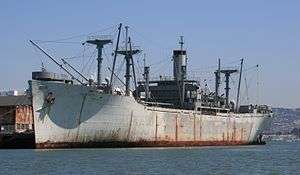
California Shipbuilding Corporation (often called Calship) built 467 Liberty and Victory ships during World War II, including Haskell-class attack transports. The Calship shipyard was created at Terminal Island in Los Angeles as part of the World War II shipbuilding effort. It was initially eight ways, then increased to 14. After the war, it was liquidated. The ships they built were:
- 306 EC2-S-C1 Liberty ship cargo transports
- 30 Z-ET1-S-C3 Liberty ship tankers
- 32 VC2-S-AP3 Victory ship cargo transports, 8,500 hp
- 30 VC2-S-AP5 Haskell class USN attack transports
- 69 VC2-S-AP2 Victory ship cargo transports, 6,000 hp
California naval bases
Mare Island Naval Shipyard
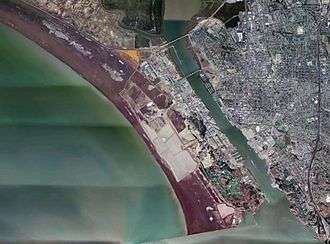
Mare Island, near the city of Vallejo, was the site of the first naval base in California. The Napa River forms the eastern side of the island as the river enters the Carquinez Strait at its juncture with the east side of San Pablo Bay. In 1850, Commodore John Drake Sloat, in charge of a commission to find a California naval base, recommended the island across the Napa River from the settlement of Vallejo, it being "free from ocean gales and from floods and freshets."
On November 6, 1850, two months after California was admitted to statehood, President Millard Fillmore reserved Mare Island for government use. The United States Navy Department acted favorably on Commodore Sloat's recommendations, and Mare Island was purchased in July 1852, for the sum of $83,410, for the use as a naval shipyard. Two years later, on September 16, 1854, Mare Island became the first permanent United States naval installation on the West Coast, with Commodore David G. Farragut as Mare Island's first base commander. For more than a century, Mare Island served as the Mare Island Naval Shipyard. A 508-foot (155 m) drydock was built by the Public Works Department on an excellent rock foundation of cut granite blocks. The work took nineteen years and was completed in 1891. During the Spanish–American War, a concrete drydock on wooden piles, 740 feet (230 m) long, was completed after eleven years of work, in 1910. By 1941, a third drydock had been completed, and drydock number four was under construction. The ammunitions depot and submarine repair base were modern, fireproof buildings. A million-dollar, three-way vehicle causeway to Vallejo was completed.
Before World War II, Mare Island had been in a continual state of upbuilding. By 1941, new projects included improvements to the central power plant, a new pattern storage building, a large foundry, machine shop, magazine building, paint shop, new administration building, and a huge storehouse. The yard was expected to be able to repair and paint six to eight large naval vessels at a time. Several finger piers had recently been built, as well as a new shipbuilding wharf, adding one 500-foot (150 m) and one 750-foot (230 m) berth. It employed 5,593 workers at the beginning of 1939, and rapidly increased to 18,500 busily engaged by May 1941, with a monthly payroll of $3,500,000 (1941). Then came the attack on Pearl Harbor. In 1941, the drafting department had expanded to three buildings accommodating over 400 naval architects, engineers and draftsmen. The hospital carried 584 bed patients. Mare Island became one of the Navy's shipbuilding sites in World War II specializing in building diesel engine-powered submarines; they eventually built 32 of them. After the war was over, Mare Island became a premier site for building nuclear-powered submarines, building 27 of them.
In 1969, the Navy transferred its (Vietnam War) Brown Water Navy Riverine Training Forces from Coronado, California, to Mare Island. Swift Boats (Patrol Craft Fast-PCF), and PBRs (Patrol Boat River), among other types of riverine craft, conducted boat operations throughout the currently named Napa-Sonoma Marshes State Wildlife Area, which are located on the north and west portions of Mare Island. Mare Island Naval Base was deactivated during the 1995 cycle of US base closures, but the US Navy Reserves still have access to the water portions of the State Wildlife Area for any riverine warfare training being conducted from their new base in Sacramento.
In 1996 Mare Island Naval Shipyard was closed.
Naval Base San Diego

Naval Base San Diego was started on land acquired in 1920. It is the largest base of the United States Navy on the west coast of the United States. Naval Base San Diego is the principal homeport of the Pacific Fleet, consisting of 54 ships and over 120 tenant commands. The base is composed of 13 piers stretched over 977 acres (3.95 km2) of land and 326 acres (1.32 km2) of water. The total on-base population is 20,000 military personnel and 6,000 civilians. San Diego has become the home port of the largest naval fleet in the world, and includes two supercarriers, as well as U.S. Marine Corps stations, United States Navy ports, and U.S. Coast Guard installations.
Growth after World War II
After the war, hundreds of land developers bought land cheap, subdivided it, built on it, and got rich. Real estate development replaced oil and agriculture as Southern California's principal industry. In 1955, Disneyland opened in Anaheim. In 1958, Major League Baseball's Dodgers and Giants left New York City and came to Los Angeles and San Francisco, respectively. The population of California expanded dramatically, to nearly 20 million by 1970.
In the late 1960s the baby-boom generation reached draft age, and many risked arrest to oppose the war in Vietnam. There were numerous demonstrations and strikes, most famously on the prestigious Berkeley campus of the University of California, across the bay from San Francisco. In 1965, race riots erupted in Watts, in the South Central area of Los Angeles. The hippie riots on the Sunset Strip in Los Angeles were immortalized by Buffalo Springfield in the song "For What It's Worth" (1966). Some commentators predicted revolution. Then the federal government promised to withdraw from the Vietnam War, which at last happened in 1974. The radical political movements, having achieved a large part of their aim, lost members and funding.
California still was a land of free spirits, open hearts, and easy-going living. Popular music of the period bore titles such as "California Girls," "California Dreamin'," "San Francisco (Be Sure to Wear Flowers in Your Hair)," "Do You Know the Way to San Jose" and "Hotel California". These reflected the Californian promise of easy living in a paradisaical climate. The surfing culture burgeoned. Many people took low-paying jobs and joined the surfers living in trailers at the beach, and many others forsook ambition and joined the hippies living in cities.
The most famous hippie hangout was the Haight-Ashbury district of San Francisco. The state's cities, especially San Francisco, became famous for their gentility and tolerance. A distinctive and idyllic Californian culture emerged for a time. The peak of this culture, in 1967, was known as the Summer of Love. California became known elsewhere in the United States often derogatorily, as the "land of fruits and nuts".
California as an economic powerhouse
Conversely, during the same period, the Golden State also attracted commercial and industrial expansion at astronomical rates. The adoption of a Master Plan for Higher Education in 1960 allowed the development of a highly efficient system of public higher education in the community colleges and the University of California and California State University systems; by creating an educated workforce, it attracted investment, particularly in areas related to high technology. By 1980, California became recognized as the world's eighth-largest economy. Millions of workers were needed to fuel the expansion. The high population of the time caused tremendous problems with urban sprawl, traffic, pollution, and, to a lesser extent, crime.
Urban sprawl created a backlash in many areas, with local governments limiting growth beyond certain boundaries, reducing lot sizes for building homes, and so on. Open space districts were created in several parts of the state specifically to obtain, manage, and preserve undeveloped land. For example, in the San Francisco Bay Area, the open space districts have created a nearly contiguous range of permanently undeveloped land running through the coastal range and hills surrounding the Bay's urban valleys, enabling the creation of huge natural parks and envisioning a hiking trail that will eventually circumnavigate the Bay in an unbroken loop.
The immense problem with air pollution (smog) that had developed by the early 1970s also caused a backlash. With schools being closed routinely in urban areas for "smog days" when the ozone levels became too unhealthy and the hills surrounding urban areas seldom visible even within a mile, Californians were ready for changes. Over the next three decades, California enacted some of the strictest anti-smog regulations in the United States and has been a leader in encouraging nonpolluting strategies for various industries, including automobiles. For example, carpool lanes normally allow only vehicles with two/three or more occupants (whether the base number is two or three depends on what freeway you are on), but electric cars can use the lanes with only a single occupant. As a result, smog is significantly reduced from its peak, although local Air Quality Management Districts still monitor the air and generally encourage people to avoid polluting activities on hot days when smog is expected to be at its worst.
Traffic and transportation remain a problem in urban areas. Solutions are implemented, but inevitably the implementation expense and the time required to plan, approve, and build infrastructure can't keep pace with the population growth. There have been some improvements. Carpool lanes have become common in urban areas, which are intended to encourage people to drive together rather than in individual automobiles. San Jose is gradually building a light rail system (often over routes of an original turn-of-the-century electric railroad line that was torn out and paved over to encourage the advent of the automobile age). None of the implemented solutions are without their critics. The sprawling nature of the Bay Area and of the Los Angeles Basin makes it difficult to build mass transit that can reach and serve a significant portion of the population.
During the 1960s, under the aegis of Chief Justice Roger J. Traynor, the California Supreme Court became more liberal and progressive. Traynor's term as Chief Justice (from 1964 to 1970) was marked by a number of firsts: California was the first state to create true strict liability in product liability cases, the first to allow the action of negligent infliction of emotional distress (NIED) even in the absence of physical injury to the plaintiff, and the first to allow bystanders to sue for NIED where the only physical injury was to a relative.
Starting in the 1960s, California became a leader in family law. California was the first state to allow true no-fault divorce, with the passage of the Family Law Act of 1969. In 1994, the Legislature took family law out of the Civil Code and created a new Family Code. In 2002, the Legislature granted registered domestic partners the same rights under state law as married spouses. In 2008 California became the second state to legalize same-sex marriage when the California Supreme Court ruled the ban unconstitutional.
Since the mid-1980s, the California Supreme Court has become more conservative, particularly with regard to the rights of criminal defendants. This is commonly seen as a reaction against the strict anti-death penalty stance of Chief Justice Rose Bird in the early 1980s, although the funding that eventually brought about her defeat was from corporate and business interests concerned with what they felt was an anti-business stance by the Chief Justice. The state's electorate responded by removing her (and two of her perceived liberal allies) from the court in November 1986.
High-tech expansion
Starting in the 1950s, high technology companies in Northern California began a spectacular growth that continued through the end of the 20th century. The major products included personal computers, video games, and networking systems. The majority of these companies settled along a highway stretching from Palo Alto to San Jose, notably including Santa Clara and Sunnyvale, all in the Santa Clara Valley, the so-called "Silicon Valley", named after the material used to produce the integrated circuits of the era.
This era peaked in 2000, by which time demand for skilled technical professionals had become so high that the high-tech industry had trouble filling all of its positions and therefore pushed for increased visa quotas so that they could recruit from overseas. When the "Dot-com bubble" burst in 2001, jobs evaporated overnight, and for the first time over the next two years more people moved out of the area than moved in. This somewhat mirrored the collapse of the aerospace industry in southern California some twenty years earlier.
2000–present
Although air pollution problems have been reduced, health problems associated with pollution have continued. The brown haze known as "smog" has been substantially abated thanks to federal and state restrictions on automobile exhaust.[147][148]
An energy crisis in 2001 led to rolling blackouts, soaring power rates, and the importation of electricity from neighboring states. Southern California Edison and Pacific Gas and Electric Company came under heavy criticism.[149]
Housing bubble bursts
The ongoing demand for well-educated workers continued. Housing prices in urban areas continued to increase so that a modest home that in the 1960s cost $25,000, cost half a million dollars or more in urban areas by 2005. More people commuted longer hours to afford a home in more rural areas while earning larger salaries in the urban areas. Speculators bought houses they never intended to live in, expecting to make a huge profit in a matter of months, then rolling it over by buying more properties. Mortgage companies were compliant, as everyone assumed the prices would keep rising. The bubble burst in 2007-8 as housing prices began to crash and the boom years ended. Hundreds of billions in property values vanished and foreclosures soared as many financial institutions and investors were badly hurt.[150][151]
In the 2002 gubernatorial campaign, Democratic incumbent Gray Davis defeated Republican challenger Bill Simon. On October 7, 2003, Davis was recalled, with 55.4% of the voters supporting the recall (see results of the 2003 California recall). With a plurality of 48.6% of the vote, Republican Arnold Schwarzenegger was chosen as the new governor. Lieutenant Governor Cruz Bustamante received 31.5% of the vote, and Republican state senator Tom McClintock received 13.5% of the vote.
Schwarzenegger began his shortened term with a soaring approval rating and soon after began implementing a conservative agenda. This initially resulted in sparring with the heavily Democratic Assembly and Senate over the state budget, battles which provided his infamous "girly men" comment but also began taking their toll on his approval rating. Schwarzenegger then embarked on a campaign to enact several ballot propositions in a 2005 special election touted as reforming California's budget system, redistricting powers, and union political fundraising. The union-led campaign spearheaded by the California Nurses Association contributed heavily to the defeat of every proposition in the special election.
Since this conspicuous failure, Schwarzenegger made a turn back to the left, criticizing the Bush Administration at many junctures, reviving his environmental agenda, and compromising with the legislature on the traditionally Democratic issue of education spending. His approval rating also revived, and he was re-elected in 2006. However, continued paralysis in state government and the inability of the legislature and governor to work out the fundamental funding questions resulted in voter disapproval of both the legislators and the governor, whose approval rating was among the lowest ever recorded pending the election of Jerry Brown in November 2010.
Religion
The 2014 Pew Religious Landscape Survey showed the religious makeup of California as follows:[152]
- Christian 63%
- 20% Evangelical Protestant
- 10% Mainline Protestant
- 2% Black Protestant
- 28% Catholic
- 4% Other Christian
- Non-Christian faiths 9%
- Unaffiliated 28%
See also
References
- Walter Nugent (2001). Into the West: The Story of Its People. Random House Digital, Inc. p. 5. ISBN 9780307426420.
- Resident Population Data – 2010 Census Archived 2011-01-01 at the Wayback Machine
- U.S. Immigration Statistics yearbook; pg. 5 accessed 11 Jan 2014
- "Historical Statistics of the United States, 1789–1945"; Accessed 14 Apr 2011
- USGS – The Great 1906 San Francisco Earthquake
- Timeline of the San Francisco Earthquake April 18 – 23, 1906 Archived 2016-03-03 at the Wayback Machine, The Virtual Museum of the City of San Francisco
- Where can I learn more about the 1906 Earthquake?, Berkeley Seismological Laboratory.
- 1906 Earthquake: What was the magnitude? Archived 2006-09-26 at the Wayback Machine USGS Earthquake Hazards Program – Northern California. Accessed September 19, 2006
- Christine Gibson Archived 2010-12-05 at the Wayback Machine, "Our 10 Greatest Natural Disasters". American Heritage, Aug./Sept. 2006.
- 1906 Earthquake: How long was the 1906 Crack? USGS Earthquake Hazards Program – Northern California. Accessed September 3, 2006
- 1906 San Francisco Quake: How large was the offset? USGS Earthquake Hazards Program — Northern California. Accessed September 3, 2006
- Officials unmoved by quake notoriety Daly City
- Seasonal Seismicity of Northern California Before the Great 1906 Earthquake, (Journal) Pure and Applied Geophysics, ISSN 0033-4553 (print) 1420-9136 (online), Volume 159, Numbers 1–3 / January, 2002, Pages 7–62.
- NPS Signal Corps History
- San Francisco Museum
- History Channel International series Mega Disasters, "San Francisco Earthquake" (2006), rebroadcast 02:00–03:00, November 8, 2008 (UTC)
- "Early California oil discoveries" Archived 2012-01-30 at Archive-It. Accessed 11 Jan 2014
- "Oil and Gas Production: History in California." Archived 2012-01-30 at Archive-It State of California. Web. 18 Mar. 2013..
- G. R. Hopkins and A. B. Coons, 1934, "Crude petroleum and petroleum products," in: Statistical Appendix to Minerals Yearbook 1932–33, US Bureau of Mines, pp.306–307.
- E. Hugenin, History of Gas Conservation in California (1945)
- "1969 Santa Barbara Oil Spill" Archived 2016-11-07 at the Wayback Machine. Accessed 12 Jan 2014
- "Giant Oil Fields of the San Joaquin Valley". Accessed 4 Jan 2014
- California gas production accessed 12 Jan 2014
- "California Uses for Natural Gas" Archived 2014-01-13 at the Wayback Machine. Accessed 12 Jan 2014
- Mansel G. Blackford, "Businessmen and the Regulation of Railroads and Public Utilities in California during the Progressive Era." Business History Review 1970 44(3): 307–319 (in JSTOR)
- Jackson K. Putnam, "The Persistence of Progressivism in the 1920s: the Case of California," Pacific Historical Review 1966 35(4): 395–411 (in JSTOR)
- Robert W. Cherny, Mary Ann Irwin, and Ann Marie Wilson, eds. California Women and Politics: From the Gold Rush to the Great Depression (University of Nebraska Press, 2011)
- W. H. Hutchinson, "Prologue to Reform: the California Anti-Railroad Republicans, 1899–1905". Southern California Quarterly 1962 44(3): 175–218
- Michael Rogin, "Progressivism and the California Electorate," Journal of American History 1968 55(2): 297–314 (in JSTOR)
- Timothy J. Lukes, "Progressivism Off-Broadway: Reform Politics in San Jose, California, 1880–1920." Southern California Quarterly 1994 76(4): 377–400
- Grace L. Miller, "The Origins of the San Diego Lincoln–Roosevelt League, 1905–1909." Southern California Quarterly 1978 60(4): 421–443
- Diane M.T. North, California at War: The State and the People during World War I (2018). online review
- Timothy J. Lyons, "Hollywood and World War I, 1914–1918." Journal of Popular Film 1.1 (1972): 15-30.
- Robert W. Cherny, "Prelude to the Popular Front: The Communist Party in California, 1931–35." American Communist History 2002 1(1): 5–42 online at EBSCO
- Nancy J. Taniguchi, "California's 'Anti-Okie' Law: An Interpretive Biography," Western Legal History: The Journal of the Ninth Judicial Circuit Historical Society (1995) 8#2 pp 272–290.
- Thomas D. Norris, "Southern Baptists and the 'Okie' Migration: A Sectarian Rebirth in California, 1930s–1940s," Locus (1989) 2#1 pp 35–47
- Peter La Chapelle, Proud to Be an Okie: Cultural Politics, Country Music, and Migration to Southern California (2007)
- James N. Gregory, "Dust Bowl Legacies: The Okie Impact on California, 1939–1989," California History (1989) 68#3 pp 74–85.
- James N. Gregory, American Exodus: The Dust Bowl Migration and Okie Culture in California (1998)
- Daniel J. B. Mitchell, "The Lessons of Ham and Eggs: California's 1938 and 1939 Pension Ballot Propositions," Southern California Quarterly, June 2000, Vol. 82 Issue 2, pp 193–218
- "Installed In-State Electric Generation Capacity by Fuel Type (MW)" Archived 2014-03-10 at the Wayback Machine. Accessed 10 March 2014
- Complete Report on the Construction of the Los Angeles Aqueduct. Los Angeles Department of Public Service. 1916. pp. 14.
- Complete report on construction of the Los Angeles Aqueduct. Los Angeles Department of Public Service. OL 23386153M.p. 14; p. 271
- Complete report on construction of the Los Angeles Aqueduct. Los Angeles Department of Public Service. OL 23386153M.p. 17; p. 271
- "Construction Begins". Los Angeles Department of Water and Power. Archived from the original on 2012-06-16. Retrieved 2012-09-13.
- "A Hundred or a Thousand Fold More Important". Los Angeles Department of Water and Power. Archived from the original on 2009-02-23. Retrieved 2009-02-07.
- Heinly, Burt A. (July 1910). "Carrying Water Through a Desert: The Story of the Los Angeles Aqueduct". The National Geographic Magazine. XXI (7): 568–596. Retrieved 2009-07-10. Includes construction photos.
- Water and Power Associates Inc. "William Mulholland Biography"
- Complete Report on the Construction of the Los Angeles Aqueduct. Los Angeles Department of Public Service. 1916. pp. 75–76.
- Complete Report on the Construction of the Los Angeles Aqueduct. Los Angeles Department of Public Service. 1916. pp. 271.
- The Second Los Angeles Aqueduct. Department of Water and Power, City of Los Angeles. 1971. pp. xvii.
- "The Owens Valley Is the Only Source". Los Angeles Department of Water and Power. Archived from the original on 2009-02-23. Retrieved 2009-02-07.
- Wurm, Ted; "Hetch Hetchy and Its Dam Railroad"; Trans Anglo Books; Reprint edition (April 1990);ISBN 978-0870460937
- "Hetch Hetchy". San Francisco Water Power Sewer. Retrieved 2013-05-23.
- Stene, Eric A. (1996). "Trinity Division: Central Valley Project". U.S. Bureau of Reclamation. Archived from the original on 2013-02-22. Retrieved 2012-02-12.
- "Shasta/Trinity River Division Project". Central Valley Project. U.S. Bureau of Reclamation. 2011-04-21. Archived from the original on 2013-02-22. Retrieved 2012-02-12.
- "Dams Owned and Operated by Federal Agencies" (PDF). California Department of Water Resources, Division of Safety of Dams. Archived from the original (PDF) on October 5, 2012. Retrieved January 2, 2013.
- Photos of Pardee Dam Archived 2014-04-07 at the Wayback Machine accessed 18 Mar 2014
- "History". East Bay Municipal Utility District. Archived from the original on 2014-01-01. Retrieved 2014-01-16.
- DWR Public Affairs Office (2005). "State Water Project Today". Department of Water Resources, State of California. Archived from the original on 2007-06-10. Retrieved 2009-03-19.
- "Edmonston Pumping Plant". Center for Land Use Interpretation. 2009. Archived from the original on 2008-07-24. Retrieved 2009-03-19.
- "California State Water Project Today". California Department of Water Resources. 2008-07-18. Retrieved 2013-09-12.
- Meier, Fred. "The California State Water Project" (PDF). University of California, Los Angeles. Archived from the original (PDF) on 2013-10-17. Retrieved 2013-10-17.
- Quinton, Amy (2013-10-07). "California's Water Supply, a 700 Mile Journey". Capital Public Radio. Retrieved 2013-10-15.
- "History of the State Water Project". State Water Contractors. Archived from the original on 2013-10-16. Retrieved 2013-10-18.
- "The Big Water Projects in California". California Water Impact Network. Archived from the original on 2013-10-01. Retrieved 2013-10-15.
- Zetland, David (August 5, 2009). "Colorado River Aqueduct" (PDF). kysq.org. Archived from the original (PDF) on July 27, 2011. Retrieved 2010-11-20.
- California Municipal Wastewater Recycling Survey-2009. Accessed 3 Apr 2014
- Water Recycling Funding Program. Accessed 3 Apr 2014
- Water Replenishment District. Accessed 3 April 2014
- WRD engineering report Archived 2014-04-01 at the Wayback Machine. Accessed 3 Apr 2014
- Water Factory 21. Accessed 3 Apr 2014
- Carlsbad Desalination Project Archived 2014-04-07 at the Wayback Machine. Accessed 3 Apr 2014
- Desalination Plant Construction Flyover, January 17, 2014. Accessed 3 Apr 2014
- California desalination plans. Accessed 3 Apr 2014
- Daily Reservoir Storage Summary of California reservoirs. Accessed 3 Apr 2014
- "An act to authorize the state of California to secure the title to and right of way for that certain wagon-road...commencing a short distance easterly from the village of Smith's Flat...and running thence to Lake Tahoe...", approved March 26, 1895, chapter 128, p. 119 Report of the Lake Tahoe Wagon Road Commissioner, November 29, 1898
- California Highways and Public Works, Centennial Edition, September 9, 1950
- Department of Engineering (1917), p. 181
- Blow, pp. 12–15
- Blow, p. 18
- "An act to provide for the construction of a state highway or wagon road from Sacramento City to Folsom...", approved March 29, 1897, chapter 176, p. 239
- "An act to provide for the construction of a free wagon road from the Mono lake basin to connect with a road called 'Tioga road,' at or near the 'Tioga mine,' and making an appropriation therefor.", approved February 23, 1899, chapter 26, p. 26
- "An act to create for the State of California a department of engineering...", approved March 11, 1907, chapter 183, p. 215
- "An act authorizing the construction, acquisition, maintenance and control of a system of state highways in the State of California...", approved March 22, 1909, chapter 383, p. 647
- Blow, pp. 27–34
- Howe & Peters, p. 12
- Automobile Clubs, p. 16
- Blow, p. 2
- Department of Engineering (1917), p. 198
- Howe & Peters, pp. 11–14
- Home & Peters, p. 18
- Howe & Peters, pp. 12–14
- How & Peters, p. 17
- California Department of Transportation, Fact Sheet: Important Events in Caltrans History
- "An act declaring the public highway extending from Auburn in Placer County to the Sonora Lateral at Sonora in Tuolumne county to be a state highway.", approved June 3, 1921, chapter 839, p. 1608
- "An act authorizing and directing the California highway commission to acquire necessary rights of way, and to construct and maintain a highway, which is hereby declared to be a state highway, extending from Barstow...to a point...on the boundary line between the state of California and the state of Nevada...which said highway is commonly known and referred to as the Arrowhead trail.", approved May 23, 1925, chapter 369, p. 670
- Route Renumbering, California Highways and Public Works, March–April 1964, p. 11
- "An act establishing certain additional state highways and classifying them as secondary highways", approved April 1, 1931, chapter 82, p. 102, in effect August 14, 1931
- 1933, chapter 767, p. 2034
- Joint Fact-Finding Committee on Highways, Streets and Bridges, California's Highway Problem, 1947, OCLC 4650558, p. 29
- [Dennis, T.H. (August 1934). "State Routes Will Be Numbered and Marked with Distinctive Bear Signs". California Highways and Public Works. 11 (8): 20–21, 32. ISSN 0008-1159 – via Archive.org.
- Richard R. Mathison, Three Cars in Every Garage: A Motorist's History of the Automobile and the Automobile Club in Southern California, Doubleday, 1968, OCLC 435368, p. 240
- Harwood, Craig; Fogel, Gary (2012). Quest for Flight: John J. Montgomery and the Dawn of Aviation in the West. Norman, Oklahoma: University of Oklahoma Press. ISBN 978-0806142647.
- "Men or Money May Soon Fly". Los Angeles Times, 1909-11-16, p.II14
- "Oil and Gas Production: History in California"
- Hatfield, David, Dominguez Air Meet, 1910. Northrop University Press, Inglewood, CA: 1976
- Onkst, David H. (c. 2002). "The First U.S. Airshows—the Air Meets of 1910". www.centennialofflight.net. United States Centennial of Flight Commission. Archived from the original on 9 May 2008. Retrieved 2008-04-25.
- accessed 14 Feb 2014
- "Early Years". JPL.
- Koppes, Clayton (1982). "JPL and the American Space Program". New Haven: Yale University Press. Missing or empty
|url=(help) - Conway, Erik M. "From Rockets to Spacecraft: Making JPL a Place for Planetary Science". Engineering and Science. pp. 2–10.
- Launius, Roger (2002). To Reach High Frontier, A History of U.S. Launch Vehicles. University of Kentucky. pp. 39–42. ISBN 978-0-8131-2721-7.
- Keymeulen, Didier; Myers, John; Newton, Jason; Csaszar, Ambrus; Gan, Quan; Hidalgo, Tim; Moore, Jeff; Sandoval, Steven; Xu, Jiajing; Schon, Aaron; Assad, Chris; Stoica, Adrian. "Humanoids for Lunar and Planetary Surface Operations". Pasadena, CA: Jet Propulsion Laboratory, National Aeronautics and Space Administration, 2006. JPL TRS 1992+. hdl:2014/39699. Missing or empty
|url=(help) - Bello, Francis (1959). "The Early Space Age". Fortune. Archived from the original on November 3, 2013. Retrieved June 5, 2012.
- Whalen, Mark; Murrill, Mary Beth (24 July 1998). "JPL will establish Near-Earth Object Program Office for NASA". Jet Propulsion Laboratory. NASA. Retrieved 19 February 2013.
- "NASA scrambles for better asteroid detection". France 24. 18 February 2013. Archived from the original on 10 April 2013. Retrieved 19 February 2013.
- Parker, Dana T. Building Victory: Aircraft Manufacturing in the Los Angeles Area in World War II, pp. 131–2, Cypress, CA, 2013. ISBN 978-0-9897906-0-4.
- Parker, Dana T. Building Victory: Aircraft Manufacturing in the Los Angeles Area in World War II, pp. 14, 50, 60, 78, 94, 108, 122, Cypress, CA, 2013. ISBN 978-0-9897906-0-4.
- Early airplane manufacturers. Accessed 14 Feb 1944
- "Home | Flight Test Historical FoundationFlight Test Historical Foundation". Afftcmuseum.org. Retrieved 2013-11-24.
- Archived October 16, 2013, at the Wayback Machine
- "Website". Archived from the original on 2014-08-25. Retrieved 2014-07-18.
- "5050 Santa Fe Drive, Atwater, California". Castle Air Museum. Retrieved 2013-11-24.
- "Joe Davies Heritage Airpark at Palmdale Plant 42 – City of Palmdale, CA official website". Cityofpalmdale.org. Archived from the original on 2017-10-29. Retrieved 2013-10-09.
- "Home Lyon Air Museum". Lyonairmuseum.org. 2013-01-18. Retrieved 2013-10-09.
- "Goleta Air and Space Museum, Pt. Mugu Missile Park". Air-and-space.com. Retrieved 2013-11-24.
- Point Mugu's Missile Park closed for renovation. Ventura County Star March 30, 2012
- "Our Menus". Theproudbird.com. 2010-06-08. Retrieved 2013-11-24.
- "Iconic Proud Bird Restaurant at LAX announces plans to close". Dailybreeze.com. 2013-09-26. Retrieved 2013-11-24.
- "Views & Beyond". Theproudbird.com. 2010-06-08. Retrieved 2013-11-24.
- "Santa Maria Museum of Flight, airplane museum, airplane history, flight history". Smmof.org. Retrieved 2013-11-24.
- "Welcome to the Colonel Vernon P. Saxon Jr. Aerospace Museum". Saxonaerospacemuseum.com. 1997-09-13. Retrieved 2013-11-24.
- "U.S. Naval Museum of Armament & Technology". Chinalakemuseum.org. 2013-11-20. Retrieved 2013-11-24.
- "Yanks Greenfield Expansion". Yanksair.com. Archived from the original on 2013-09-29. Retrieved 2013-10-09.
- "Yanks Air Museum in Greenfield growing | Salinas News – KSBW Home". Ksbw.com. 2013-06-07. Archived from the original on 2013-10-09. Retrieved 2013-10-09.
- Ships built in U.S. in WW-II Archived 2013-11-25 at the Wayback Machine Accessed 12 February 2012
- Kaiser Permanente Yard #1 Richmond, California Accessed 8 February 2012
- Kaiser Permanente Yard #2 Richmond, California Accessed 8 February 2012
- Kaiser Permanente Yard #3 Richmond, California Accessed 8 February 2012
- Kaiser Permanente Yard #4 Richmond, California Accessed 8 February 2012
- Kaiser, California Shipbuilding Los Angeles Archived 2012-05-10 at the Wayback Machine Accessed 8 February 2012
- Richmond Shipyards Images Images and oral history transcripts describing the early days of the Richmond Shipyards Accessed 13 June 2011
- Kaiser Permanente Shipyard building etc. Archived 2013-08-29 at the Wayback Machine Accessed 12 February 2012
- Map of Kaiser-Permanente Yard #1, #2 Archived 2012-02-13 at the Wayback Machine Accessed 12 February 2012
- Kaiser Shipyards Permanente Metals Corporation – Kaiser Richmond CA Shipyards Archived 2013-08-29 at the Wayback Machine 13 June 2011
- William Deverell, and Greg Hise, eds. Land of Sunshine: An Environmental History of Metropolitan Los Angeles (2005).
- James E. Krier, and Edmund Ursin, Pollution and Policy: A Case Essay on California and Federal Experience with Motor Vehicle Air Pollution, 1940–1975 (1978)
- Severin Borenstein, "The Trouble With Electricity Markets: Understanding California's Restructuring Disaster", Journal of Economic Perspectives, Winter 2002, Vol. 16 Issue 1, pp. 191–211 (in JSTOR)
- Robert M. Hardaway, The Great American Housing Bubble: The Road to Collapse (2011) p. 22
- Stephen D. Cummings and Patrick B. Reddy, California after Arnold (2009) p. 102
- Pew Research Center, "Religious Landscape Study: California"
Bibliography
Scholarly surveys
- Aron, Stephen. "Convergence, California and the Newest Western History," California History Volume: 86#4 September 2009. pp 4+ historiography.
- Bakken, Gordon Morris. California History: A Topical Approach (2003)
- Cherney, Robert W., Richard Griswold del Castillo, and Gretchen Lemke-Santangelo. Competing Visions: A History of California (2005)
- Deverell, William, and David Igler, eds. A Companion to California History (2008), long essays by scholars; excerpt and text search
- Glass, Fred. From Mission to Microchip: A History of the California Labor Movement (U of California Press, 2016). xviii, 524 pp.
- Hart, James D. A Companion to California (2nd ed. 1987), 591 pp; encyclopedia of state history
- Hayes, Derek. Historical Atlas of California: With Original Maps (2007), 256pp
- North, Diane M.T. California at War: The State and the People during World War I (2018).
- Pitt, Leonard, and Dale Pitt. Los Angeles A to Z: An Encyclopedia of the City and County (2000)
- Rawls, James J. ed. New Directions in California History: A Book of Readings (1988)
- Rawls, James; Walton Bean (2003). California: An Interpretive History. ISBN 0-07-052411-4. 8th edition
- Rice, Richard B., William A. Bullough, and Richard J. Orsi. Elusive Eden: A New History of California 3rd ed. (2001)
- Rolle, Andrew F. California: A History 6th ed. (2003)
- Starr, Kevin (Note that there are numerous editions of this monumental state history, with slight title changes)
- Starr, Kevin California: A History (2005), one-volume synthesis
- Americans and the California Dream, 1850–1915 (1973)
- Inventing the Dream: California through the Progressive Era (1986)
- Material Dreams: Southern California through the 1920s (1991)
- Endangered Dreams: The Great Depression in California (1997)
- The Dream Endures: California Enters the 1940s (1997)
- Embattled Dreams: California in War and Peace, 1940–1950 (2003)
- Coast of Dreams: California on the Edge, 1990–2003 (2004)
- Sucheng, Chan, and Spencer C. Olin, eds. Major Problems in California History (1996)
Environment, transportation, agriculture, water
- Carle, David. Introduction to Water in California (2004). 261 pp.
- Deverell, William and Hise, Greg, eds. Land of Sunshine: An Environmental History of Metropolitan Los Angeles. U. of Pittsburgh Press, 2005. 350 pp. excerpt and online search
- Deverell, William. Railroad Crossing: Californians and the Railroad, 1850–1910 (1994). 278 pp.
- Godfrey, Anthony. The Ever-Changing View: A History of the National Forests in California. US Forest Service, 2005. 657 pp.
- Griggs, Gary; Patsch, Kiki; and Savoy, Lauret, eds. Living with the Changing California Coast (2005). 540 pp.
- Hundley Jr., Norris. The Great Thirst: Californians and Water—A History (2nd ed. 2001) excerpt and text search
- Isenberg, Andrew C. Mining California: An Ecological History (2005). 242 pp.
- Jelinek, Lawrence. Harvest Empire: A History of California Agriculture (1982)
- Merchant, Carolyn, ed. Green Versus Gold: Sources in California's Environmental History (1998). Readings in primary and secondary sources; excerpt and text search
- Pincetl, Stephanie S. Transforming California: A Political History of Land Use and Development (2003) excerpt and text search
- Righter, Robert W. The Battle over Hetch Hetchy: America's Most Controversial Dam and the Birth of Modern Environmentalism (2005). 303 pp.
- Sackman, Douglas Cazaux. Orange Empire: California and the Fruits of Eden (2005). 386 pp.
- Street, Richard Steven. Beasts of the Field: A Narrative History of California Farmworkers, 1769–1913 (2004). 904 pp.
- Thompson, Gregory Lee. The Passenger Train in the Motor Age: California's Rail and Bus Industries, 1910–1941 (1993). 247 pp.
- Vogel, David. California Greenin’: How the Golden State Became an Environmental Leader (2018) 280 pp online review
Scholarly specialty studies
- Abelmann, Nancy, and John Lie. Blue Dreams: Korean Americans and the Los Angeles Riots (1995)
- Aron, Stephen. "Convergence, California and the Newest Western History," California History Vol. 86#4, September 2009. pp 4+ historiography.
- Bell, Jonathan. "Social Democracy and the Rise of the Democratic Party in California, 1950–1964." Historical Journal 49.2 (2006): 497-524. online
- Fogelson, Robert M. The Fragmented Metropolis: Los Angeles, 1850–1930 (1993)
- Miller, Sally M., and Daniel A. Cornford, eds. American Labor in the Era of World War II (1995). Essays by scholars, mostly on California
- Roger W. Lotchin. Fortress California, 1910–1961 (2002)
- George E. Mowry. The California Progressives (1963)
- Sackman, Douglas Cazaux. Orange Empire: California and the Fruits of Eden. (2005) comprehensive, multidimensional history of citrus industry
- Pincetl, Stephanie S. Transforming California: A Political History of Land Use and Development (2003)
- Sitton, Tom and William F, Deverell, eds. Metropolis in the Making: Los Angeles in the 1920s (2001)
- Swiontek, Danielle Jean. With Ballots and Pocketbooks: Women, Labor, and Reform in Progressive California (2006)
- Westwick, Peter J., ed. Blue Sky Metropolis: The Aerospace Century in Southern California (U of California Press; 2012) 308 pages; essays by scholars
